If this symbol - “ω” - is not a lower
case omega inside quotation marks you should go the
Browser Selection
Considerations page.
Volume 104, Number 4, July – August 1999
Journal of Research of the National Institute of
Standards and Technology
[J. Res. Natl. Inst. Stand. Technol.104 , 349 (1999)]
A Conceptual Data Model of Datum Systems
Michael R. McCaleb
National Institute of Standards and Technology
Gaithersburg, MD 20899-0001
Table of Contents
Abstract
A new conceptual data model that addresses the geometric
dimensioning and tolerancing concepts of datum systems,
datums, datum features, datum targets, and the
relationships among these concepts, is presented.
Additionally, a portion of a related data model, Part 47 of
STEP (ISO 10303-47), is reviewed and a comparison is made
between it and the new conceptual data model.
Keywords: data model; datum; datum feature; datum
system; datum target..
Accepted: June 3, 1999
Available in PDF for printing from the NIST Virtual
Library. Go!

1. Introduction
Traditionally, geometric dimensioning and tolerancing
(GD&T) requirements have been exchanged with
technical drawings. However, with the advent of
computer-aided design, manufacturing, and inspection
equipment, the ability to exchange these requirements in
a computer-sensible manner has become increasingly more
desirable. As“a data model is an effective
technique to define the shareable semantics that are
essential to the success of data communication in an
integrated environment ” [1], a conceptual data
model has been developed that defines a portion of the
semantics necessary for the electronic exchange of
GD&T data among the design, manufacturing, and
inspection divisions of an enterprise. The portion of the
semantics that this data model defines encompasses the
concepts of datum systems, datums, datum features, and
datum targets. This paper presents this data model, which
will be referred to throughout the remainder of the paper
as the DSCDM (Datum System Conceptual Data Model).
Additionally, a portion of the data model presented in
STEP Part 47 [2] is reviewed and a comparison is made
between it and the DSCDM. The model presented in STEP
Part 47 will be referred to as“ the Part 47 model
”throughout the remainder of this paper.
-
NOTE — Though the scope of the DSCDM is limited
to the concepts mentioned above, the aim is to provide
a foundation upon which more comprehensive GD&T;
data models may be based.
NOTE — The following conventions are employed
throughout the course of this paper. To distinguish
between EXPRESS entities and the objects they
represent, entity names are printed in bold type and
the objects they represent are printed in non-bold
type. Furthermore, entity names start with a leading
uppercase letter (e.g., Datum is an entity
name and datum refers to the object). Attribute names
are printed in italic type (e.g.,
established_datum ). Additionally, permissible
values from enumerated data types are printed in all
uppercase letters (e.g., MAXIMUM_MATERIAL_PRINCIPLE).
NOTE — The data models in this paper are
presented in EXPRESS-G notation. EXPRESS-G is a
graphical notation that supports a subset of the
EXPRESS data modelling language. Both EXPRESS and
EXPRESS-G are defined in ISO 10303-11 [3]. An
overview of theEXPRESS-G notation is presented in
Appendix A of this paper as an aid to those who are
unfamiliar with EXPRESS-G.
-

2. Requirements
“The first step in data modeling is to define the
data requirements” [1]. In regard to the DSCDM, the
requirements came from existing GD&T;
drawing-basedstandards (e.g., ASME Y14.5M [4], ISO 1101
[5], and ISO 5459 [6]). The reason that these existing
GD&T; standards are used to define the requirements
of the DSCDM is due in part to the fact that the DSCDM is
based on parts of a larger GD&T; model that the
author developed for STEP AP 210, Electronic assembly,
interconnect and packaging design [7]. With the
increased geometric complexity of printed circuit boards,
printed circuit assemblies, and electronic components, it
was deemed by members of the STEP AP 210 development team
that the concepts presented in these GD&T; drawing-
based standards that are typically considered applicable
to mechanical products are also applicable to the
electronic products to which STEP AP 210 pertains.
Consequently, these drawing-based standards define the
main requirements of the GD&T; model and subsequently
of the DSCDM. Consequently, most of the definitions in
Sec. 3 of this paper, which define the concepts that form
the basis for the requirements of the DSCDM, are from
these standards and associated reference books.
Furthermore, most of the diagrams and examples presented
in this paper are from these same sources. These diagrams
and examples not only aid in explaining the DSCDM, but
also provide a set of test cases by which the validity of
both the DSCDM and the Part 47 model may be judged.

3. Geometric Dimensioning and Tolerancing Definitions
Most of the following definitions are from existing
drawing-based GD&T; standards and associated
reference books. These definitions are important, because
they explain some of the concepts that are at the
foundation of these GD&T; standards, and consequently
form the basis for the requirements of the DSCDM.
Datum: “A theoretically exact point, axis, or plane
derived from the true geometric counterpart of a
specified datum feature. A datum is the origin from which
the location or geometric characteristics of features of
a partare established ” [4].
Datum Feature: “ An actual feature of a part that
is used to establish a datum ”[4].
Datum Feature Symbol: “ The symbolic means of
indicating a datum feature consists of a capital letter
enclosed in a square frame and a leader line extending
from the frame to the concerned feature, terminating with
a triangle ” [4].
Datum System: “ A group of two or more separate
datums used as a combined reference for a toleranced
feature ” [6].
Datum Reference Frame: A framework that consists of three
mutually perpendicular datum planes, three datum axes
(located at the intersection of each pair of datum
planes), and a datum point (that is located at the
intersection of the three datum planes).
Datum Target: “ A specified point, line, or area on
a part used to establish a datum ” [4].
Datum Target Frame: “ The datum targets are
indicated by a circular frame divided in two compartments
by a horizontal line. The lower compartment is reserved
for a letter and a digit. The letter represents the datum
feature and the digit the datum target number. The upper
compartment is reserved for additional information, such
as dimensions of the target area. If there is not
sufficient space within the compartment, the information
may be placed outside and connected to the appropriate
compartment by a leader line ” [6].
Feature:“ The general term applied to a physical
portion of a part, such as a surface, pin, tab, hole, or
slot ” [4].
Feature Control Frame: “ The feature control frame
is a rectangular box containing the geometric
characteristic symbol and the form, orientation, profile,
runout, or location tolerance. If necessary, datum
references and modifiers applicable to the feature or the
datums are also contained in the box, e.g. ”
 [8].
[8].
Feature of Size:“ One cylindrical or spherical
surface, or a set of two opposed elements or opposed
parallel surfaces, associated with a size dimension
” [4].
Least Material Condition (LMC): “ The condition in
which a feature of size contains the least amount of
material within the stated limits of size — for
example, maximum hole diameter, minimum shaft diameter
” [4].
Least Material Requirement: “ The least material
requirement permits an increase in the stated
geometrical tolerance when the concerned feature departs
from its least material condition (LMC) ” [9].
Maximum Material Condition (MMC): “ The condition
in which a feature of size contains the maximum amount of
material within the stated limits of size — for
example, minimum hole diameter, maximum shaft diameter
” [4].
Maximum Material Principle: “ The maximum
material principle is a tolerancing principle which
requires that the virtual condition for the toleranced
feature(s) and, if indicated, the maximum material
condition of perfect form for datum feature(s), shall not
be violated ” [10].
Regardless of Feature Size (RFS):“The term used to
indicate that a geometric tolerance or datum reference
applies at any increment of size of the feature within
its size tolerance”[4].

4. The Datum System Conceptual Data Model
STEP integrated generic resources are a series of STEP
parts that define resource constructs that are
context-independent. The underlying structure of the
DSCDM is based on four entities from the STEP integrated
generic resources. These entities are Shape_aspect
, Shape_aspect_relationship ,
Property_definition , and
Property_definition_relationship . A review of
these entities is presented in Appendix B of this paper.
The DSCDM is presented in the EXPRESS-Gdiagram shown in
Fig. 1. The entities are organized on the page such that
the entities based on the Shape_aspect entity of
STEP Part 41 [11] are at the top of the page. Immediately
below the Shape_aspect based entities are the
entities based on the Shape_aspect_relationship
entity of STEP Part 41. At the bottom of the page are the
entities based on the Property_definition entity
of STEP Part 41. Note that the DSCDM does not actually
contain entities based on the
Property_definition_relationship entity of STEP
Part 45 [12]. Instead, in the interest of simplicity,
Property_definition based entities are related
with attributes that have been included in the
Property_definition based entities. For
example,instead of specifying a
Property_definition_relationship based entity in
theDSCDM to relate the Datum_system_definition
entity with the Datum_precedence_assignment
entity, the relationship between these two entities is
established by the assigned_datum_precedences
attribute of the Datum_system_definition entity.
-
NOTE — While no
Property_definition_relationship based entities
exist in the DSCDM, they exist in spirit wherever two
Property_definition based entities are related.
-
The definitions of the entities presented in Fig. 1 are
defined below. These definitions are presented in
theorder they appear on the page. That is, the
Shape_aspect based entities are first, followed by
the Shape_aspect_relationship based entities, and
finally, the Property_definition based entities.
Fig. 1. EXPRESS-G diagram of the DSCDM.
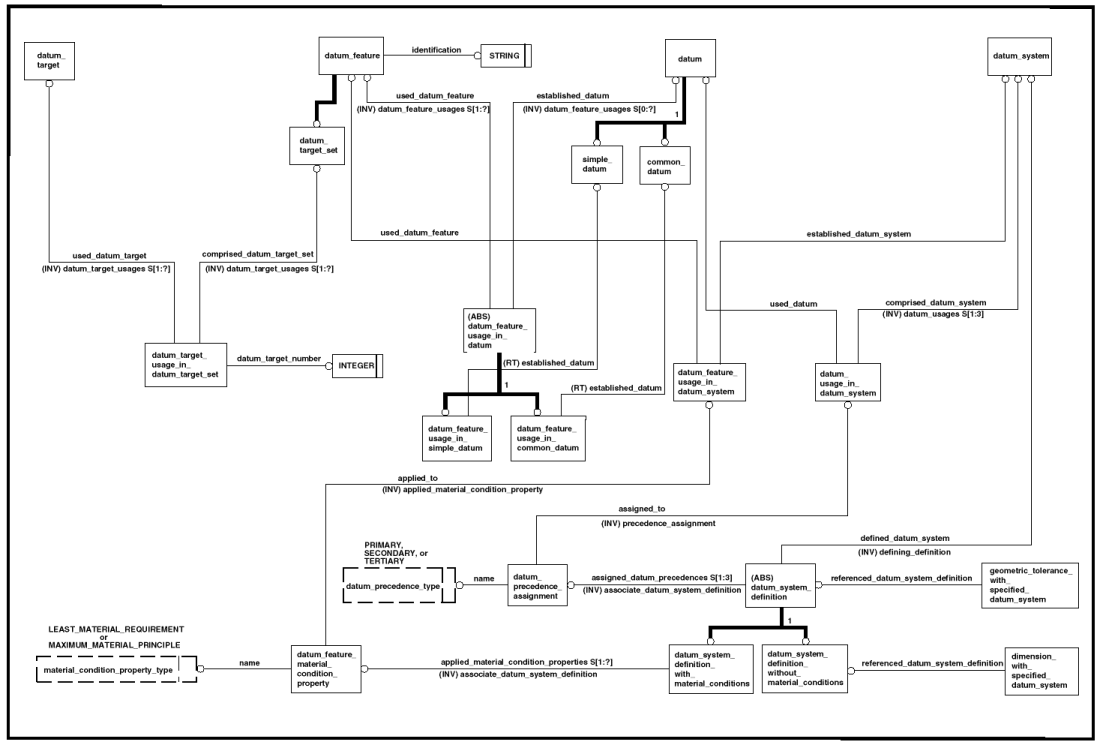

4.1. Datum_system
A Datum_system corresponds to a datum system (see
Sec. 3 of this paper) that is comprised of one to three
datums.
-
NOTE — The Datum_system entity is based on
the Shape_aspect entity of STEP Part 41 [11].
NOTE — The definition of datum system as
defined in ISO 5459-1981 is given in Sec. 3 of this
paper. However, for the purpose of this model, the
definition of datum system has been extended so that
a datum system may be comprised of a single datum.
-
Inverse attribute definitions:
datum_usages: The datum_usages attribute
specifies a set of one to three
Datum_usage_in_datum_system s. Each of the
Datum_usage_in_datum_system s in this set
corresponds to the usage of a datum in the datum system.
defining_definition: The
defining_definition attribute specifies the
Datum_system_definition that specifies the
characteristics of the corresponding datum system (e.g.,
the order in which each datum is established within the
datum system).
-
NOTE — On technical drawings, the characteristics
of a datum system are typically specified in a feature
control frame.
EXAMPLE — Both Figs. 2 (b) and (c) contain a
feature control frame, each of which specifies a
datum system that consists of three datums (datums A,
B, and C). However, these two datum systems are
different, as the order that the datums are
established within each datum system differs (i.e.,
they have a different datum precedence). Figure 2
illustrates the effect that datum precedence has on a
datum system.
-
Constraints:
WR1: Of the Datum_feature s specified as the
used_datum_feature by the
Datum_feature_usage_in_datum s that are specified
as the datum_feature_usages by the Datum s
that are specified as the used_datum by the
Datum_usage_in_datum_system s that are specified
as the datum_usages of the Datum_system ,
no Datum_feature may be specified more than once.
-
NOTE — WR1 corresponds to the assertion that each
datum feature shall not be used more than once in
establishing any one datum system.
-
WR2: Of the Datum_target s specified as the
used_datum_target by the
Datum_target_usage_in_datum_target_set s specified
as the datum_target_usage by the
Datum_target_set s specified as the
used_datum_feature by the
Datum_feature_usage_in_datum s that arespecified
as the datum_feature_usages by the Datums
that are specified as the used_datum by the
Datum_usage_in_datum_system s that are specified
as the datum_usages of the Datum_system ,
no Datum_target may be specified more than once.
-
NOTE — WR2 corresponds to the assertion that each
datum target shall not be used more than oncein
establishing any one datum system.
-
Fig. 2. Effects of datum precedence on a datum system.


4.2. Datum
A Datum corresponds to a datum (see Sec. 3 of this
paper). A Datum may be either a
Simple_datum or a Common_datum .
-
NOTE — The Datum entity is based on the
Shape_aspect entity of STEP Part 41 [11].
-
Inverse attribute definitions:
datum_feature_usages: The
datum_feature_usages attribute specifies a set of
zero or more Datum_feature_usage_in_datum s. Each
of the Datum_feature_usage_in_datum s in this set
corresponds to the usage of a datum feature in
establishing the datum.

4.3. Simple_datum
A Simple_datum is a type of Datum that
corresponds to a datum that is established from exactly
one datum feature.
Constraints:
WR1: Each Simple_datum shall be specified as the
used_datum by at least one
Datum_usage_in_datum_system .
-
NOTE — WR1 corresponds to the assertion that each
simple datum shall be used in at least one datum
system.
-
WR2: Each Simple_datum shall specify exactly one
Datum_feature_usage_in_simple_datum as its
datum_feature_usages .
-
NOTE — WR2 corresponds to the assertion that each
simple datum shall be established from exactly one
datum feature.
-

4.4. Common_datum
A Common_datum is a type of Datum that
corresponds to a datum that is established from more than
one datum feature.
-
NOTE — On technical drawings, a datum that is
established from multiple datum features is indicated
by placing the identifying letters of the datum
features, separated by a dash, within a single
compartment in a feature control frame. There is no
significance to the order of the datum feature
identifying letters within a compartment of the feature
control frame.
EXAMPLE — The technical drawing presented in
Fig. 3 shows a datum plane that is established from
two datum features (datum features A and B).
-
Fig. 3. Technical drawing illustrating a common datum.
This figure is a reproduction of FIG. 4-20 presented in
ASME Y14.5M [4].
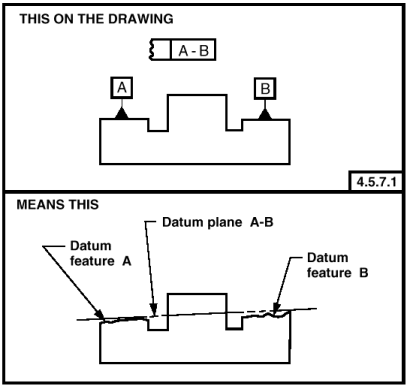
Constraints:
WR1: Each Common_datum shall be specified as the
used_datum by at least one
Datum_usage_in_datum_system .
-
NOTE — WR1 corresponds to the assertion that each
common datum shall be used in at least one datum
system.
-
WR2: Each Common_datum shall specify more than one
Datum_feature_usage_in_common_datum as its
datum_ feature_usages.
-
NOTE — WR2 corresponds to the assertion that each
common datum shall be established from more than one
datum feature.
-

4.5. Datum_feature
A Datum_feature corresponds to a datum feature
(see Sec. 3 of this paper). A Datum_feature may be
a Datum_target_set .
-
NOTE — The Datum_feature entity is based
on the Shape_aspect entity of STEP Part 41 [11].
NOTE — On technical drawings, a feature is
typically identified as a datum feature by means of a
datum feature symbol, e.g.,  .
.
NOTE — The concept of datum feature in the
DSCDM applies to features that are used to establish
one or more datums. Features that may be used as
datum features include“partial ”features
and datum target sets, as well
as“complete” and composite features. The
concept of datum feature in the DSCDM does not
pertain to features in which only a portion of the
feature (i.e., a“partial” feature or a
datum target set) is used to establish one or more
datums. “Partial” and composite features
are discussed in Sec. 10.2 of this paper.
-
Attribute definitions :
identification: Theidentification attribute
specifies the string value by which the corresponding
datum feature is referred.
-
NOTE — On technical drawings, each datum feature
is referred to by an identifying letter, (e.g., the
letter“A” in the datum feature symbol
 ).
).
EXAMPLE — Two datum features are identified in
Fig. 3, datum feature A and datum feature B.
-
Inverse attribute definitions:
datum_ feature_usages: The
datum_feature_usages attribute specifies a set of
one or more Datum_feature_usage_in_datum s.Each of
the Datum_feature_usage_in_datum s in this set
corresponds to the usage of the datum feature in
establishing a datum.
Constraints:
WR1: There shall be at most one
Datum_feature_usage_in_simple_datum in the set of
Datum_feature_usage_in_datum s specified as the
datum_ feature_usages .
-
NOTE — WR1 corresponds to the assertion that each
datum feature shall be used to establish at most one
simple datum (a datum that is established from a single
datum feature).
-

4.6. Datum_target_set
A Datum_target_set is a type of
Datum_feature that corresponds to a set of one or
more datum targets (see Sec. 3 of this paper).
-
EXAMPLE — There are three datum target sets shown
in the technical drawing presented in Fig. 4 (datum
target sets A, B, and C). The letters in the lower
compartment of the datum target frames (e.g.,
 ) indicate in which datum target sets the
associated datum targets are used.
) indicate in which datum target sets the
associated datum targets are used.
-
Inverse attribute definitions:
datum_target_usages: Thedatum_target_usages
attribute specifies a set of one or more
Datum_target_usage_in_datum_target_set s. Each of
the Datum_target_usage_in_datum_target_set s in
this set corresponds to the usage of a datum target in
the datum target set.
Fig. 4. Technical drawing illustrating datum target sets.
This figure is a reproduction of a technical drawing
presented in Figure 42 of ISO 5459 [6].
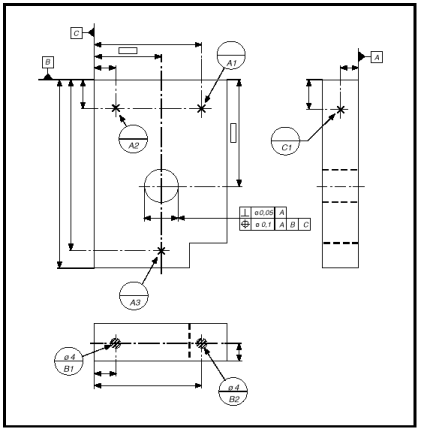

4.7. Datum_target
ADatum_targetcorresponds to a datum target (see Sec. 3 of
this paper).
-
NOTE —The Datum_target entity is based on
the Shape_aspect entity of STEP Part 41 [11].
NOTE — Datum targets are typically used in
situations where it is inappropriate to specify an
entire surface as a datum feature.
EXAMPLE — There are six datum targets shown in
Fig. 4. Four of these datum targets are datum target
points, each of which is represented by an ×.
The other two datum targets are datum target areas,
each of which is represented by a cross-hatched
circular area.
-
Inverse attribute definitions:
datum_target_usage s: The
datum_target_usage sattribute specifies a set of
one or more Datum_target_usage_in_datum_target_set
s. Each of the
Datum_target_usage_in_datum_target_set s in this
set corresponds to the usage of the datum target in a
datum target set.

4.8. Datum_usage_in_datum_system
A Datum_usage_in_datum_system corresponds to the
usage of a datum in a datum system.
-
NOTE — The Datum_usage_in_datum_system
entity is based on the Shape_aspect_relationship
entity of STEP Part 41 [11].
-
Attribute definitions:
comprised_datum_system : The
comprised_datum_system attribute specifies the
Datum_system that corresponds to the datum system
that is either partially or wholly comprised of the
corresponding datum.
used_datum: The used_datum attribute
specifies the Datum that corresponds to the datum
that is used in the corresponding datum system.
Inverse attribute definitions:
precedence_assignment : The
precedence_assignment attribute specifies the
Datum_precedence_assignment that corresponds to
the specification of the order in which the datum is
established within the datum system.
Constraints:
UR1: The combination of comprised_datum_system and
used_datum shall be unique within a population of
Datum_usage_in_datum_system .
-
NOTE — UR1 corresponds to the assertion that each
datum shall not be used more than once in any one datum
system.
-
WR1: The Datum specified as the used_datum
shall either be a Common_datum or
Simple_datum .
-
NOTE – WR1 corresponds to the assertion that each
datum that is used in a datum system shall be
established from one or more datum features.
-

4.9. Datum_feature_usage_in_datum_system
A Datum_feature_usage_in_datum_system corresponds
to the usage of a datum feature in establishing a datum
system.
-
NOTE — The
Datum_feature_usage_in_datum_system entity is
based on the Shape_aspect_relationship entity of
STEP Part 41 [11].
NOTE — The relationship between a
Datum_feature and a Datum_system is
indirectly established with a
Datum_feature_usage_in_datum , a Datum
, and a Datum_usage_in_datum_system .
Therefore, a
Datum_feature_usage_in_datum_system should not
be used unless it is necessary to indicate the
application of either the least material
requirement or the maximum material principle
(see Sec. 3 of this paper) to a datum feature within
the context of a datum system. In essence, a
Datum_feature_usage_in_datum_system
corresponds to a datum feature in the context of a
datum system.
-
Attribute definitions:
established_datum_system : The
established_datum_system attribute specifies the
Datum_system that corresponds to the datum system
that is established from the corresponding datum feature.
used_datum_feature : The used_datum_feature
attribute specifies the Datum_feature that
corresponds to the datum feature that is used to
establish the corresponding datum system.
Inverse attribute definitions:
applied_material_condition_property : The
applied_material_condition_property attribute
specifies the
Datum_feature_material_condition_property that
corresponds to the specification of a material condition
property (i.e., least material requirement or the
maximum material principle ) that is applied to the
datum feature in the context of the datum system.
Constraints:
WR1: The Datum_feature specified as the
used_datum_ feature shall be specified as the
used_datum_ feature by a
Datum_feature_usage_in_datum that specifies a
Datum as the established_datum , and that
Datum shall be specified as the used_datum
by a Datum_usage_in_datum_system that specifies
the same Datum_system as the
comprised_datum_system , as is specified as the
established_datum_system by the
Datum_feature_usage_in_datum_system .
-
NOTE — WR1 corresponds to the assertion that the
datum feature shall be used to establish a datum that
is used in the datum system.
-

4.10. Datum_feature_usage_in_datum
A Datum_feature_usage_in_datum corresponds to the
usage of a datum feature in establishing a datum. A
Datum_feature_usage_in_datum is either a
Datum_feature_usage_in_simple_datum or a
Datum_feature_usage_in_common_datum .
-
NOTE — The Datum_feature_usage_in_datum
entity is based on the Shape_aspect_relationship
entity of STEP Part 41 [11].
-
Attribute definitions:
established_datum: The established_datum
attribute specifies the Datum that corresponds to
the datum that is established from the corresponding
datum feature.
used_datum_feature : The used_datum_feature
attribute specifies the Datum_feature that
corresponds to the datum feature that is used to
establish the corresponding datum.

4.11. Datum_feature_usage_in_simple_datum
A Datum_feature_usage_in_simple_datum is a type of
Datum_feature_usage_in_datum that corresponds to
the usage of a datum feature in establishing a datum that
is established from exactly one datum feature.
Attribute definitions:
established_datum: The established_datum
attribute specifies the Simple_datum that
corresponds to the datum that is established from the
corresponding datum feature.
-
NOTE — “The corresponding datum
feature” refers to the datum feature that
corresponds to the Datum_feature specified by
the inherited used_datum_ feature attribute.
-

4.12. Datum_feature_usage_in_common_datum
A Datum_feature_usage_in_common_datum is a type of
Datum_feature_usage_in_datum that corresponds to
the usage of a datum feature in establishing a datum that
is established from more than one datum feature.
Attribute definitions:
established_datum : The established_datum
attribute specifies the Common_datum that
corresponds to the datum that is established, in part,
from the corresponding datum feature.
-
NOTE — “The corresponding datum
feature” refers to the datum feature that
corresponds to the Datum_feature specified by
the inherited used_datum_feature attribute .
-

4.13. Datum_target_usage_in_datum_target_set
A Datum_target_usage_in_datum_target_set
corresponds to the usage of a datum target in a set of
datum targets.
-
NOTE — The
Datum_target_usage_in_datum_target_set entity is
based on the Shape_aspect_relationship entity of
STEP Part 41 [11].
NOTE — On technical drawings, the usage of a
datum target in a datum target set is indicated with
a datum target frame, e.g., the  symbolin
Fig. 4. The letter in the lower compartment of a
datum target frame identifies the datum target set in
which the associated datum target is used, and the
number (datum target number) in the lower compartment
is an integer value by which the associated datum
target is identified within the datum target set.
symbolin
Fig. 4. The letter in the lower compartment of a
datum target frame identifies the datum target set in
which the associated datum target is used, and the
number (datum target number) in the lower compartment
is an integer value by which the associated datum
target is identified within the datum target set.
EXAMPLE — The  datum target
frame in Fig. 4 indicates that the datum target
pointed to by the connected leader line is used
within datum target set A.
datum target
frame in Fig. 4 indicates that the datum target
pointed to by the connected leader line is used
within datum target set A.
-
Attribute definitions:
comprised_datum_target_set : The
comprised_datum_target_set attribute specifies the
Datum_target_set that corresponds to the datum
target set that is either partially or wholly comprised
of the corresponding datum target.
datum_target_number : The
datum_target_number attribute specifies the
integer value by which the corresponding datum target is
identified within the corresponding datum target set.
-
NOTE — Datum target numbers are described in
7.1.1 of ISO 5459 [6].
EXAMPLE — The datum target number
“1”in the  datum target
frame of Fig. 4 is the integer value by which the
associated datum target is identified within datum
target set A.
datum target
frame of Fig. 4 is the integer value by which the
associated datum target is identified within datum
target set A.
-
used_datum_target : The used_datum_target
attribute specifies the Datum_target that
corresponds to a datum target that is used in the
corresponding datum target set.
Constraints:
UR1: The combination of used_datum_target and
defined_datum_target_set shall be unique within a
populationof
Datum_target_usage_in_datum_target_set .
-
NOTE — UR1 corresponds to the assertion that each
datum target shall not be used in any one datum target
set more than once.
-
UR2: The combination of datum_target_number and
defined_datum_target_set shall be unique within a
population of
Datum_target_usage_in_datum_target_set .
-
NOTE — UR2 corresponds to the assertion that
within a datum target set each datum target shall be
identified by a unique datum target number.
-

4.14. Datum_system_definition
A Datum_system_definition corresponds to the
specification of the characteristics of a datum system.
These characteristics include the order in which the
datums are established within the datum system and
anymaterial condition properties (i.e., least material
requirement or maximum material principle )
that are explicitly applied to datum features within the
context of the datum system. A
Datum_system_definition shall either be a
Datum_system_definition_with_material_conditions
or a
Datum_system_definition_without_material_conditions
.
-
NOTE — The Datum_system_definition entity
is based on the Property_definition entity of
STEP Part 41[11].
NOTE — On technical drawings, the
characteristics of a datum system are typically
specified in a feature control frame.
-
Attribute definitions:
defined_datum_system : The
defined_datum_system attribute specifies the
Datum_system that corresponds to the datum system
the characteristics of which are specified.
assigned_datum_ precedences : The
assigned_datum_ precedences attribute specifies a
set of one to three Datum_ precedence_assignment
s. Each of the Datum_ precedence_assignment s in
this set corresponds to the specification of the order in
which a datum is established within the datum system.
Constraints:
WR1: Each Datum_ precedence_assignment within the
set of Datum_ precedence_assignment s specified as
the assigned_datum_ precedences shall specify as
its assigned_to a
Datum_usage_in_datum_system that specifies as its
comprised_datum_system the same
Datum_system as specified as the
defined_datum_system .
-
NOTE — WR1 corresponds to the assertion that each
datum system specification shall only specify the
precedence of datums used in the datum system that the
specification characterizes.
-
WR2: A Datum_ precedence_assignment that has a
name of TERTIARY shall not exist within the set of
Datum_ precedence_assignment s specified as the
assigned_datum_ precedences unless a Datum_
precedence_assignment exists within that set that has
a name of SECONDARY.
-
NOTE — WR2 corresponds to the assertion that each
datum system specification that specifies a tertiary
datum shall also specify a secondary datum.
-
WR3: A Datum_ precedence_assignment that has a
name of SECONDARY shall not exist within the set
of Datum_ precedence_assignment s specified as the
assigned_datum_ precedences unless a Datum_
precedence_assignment exists within that set that has
aname of PRIMARY.
-
NOTE — WR3 corresponds to the assertion that each
datum system specification that specifies a secondary
datum shall also specify a primary datum.
-
WR4: Each Datum_system_definition shall be
specified as the
referenced_datum_system_definition by at least one
Geometric_tolerance_with_specified_datum_system or
Dimension_with_specified_datum_system .
-
NOTE — WR4 corresponds to the assertion that each
datum system specification shall be referenced by at
least one geometric tolerance or dimension.
-

4.15. Datum_system_definition_with_material_conditions
A Datum_system_definition_with_material_conditions
is a type of Datum_system_definition that
corresponds to a specification of a datum system that
specifies the application of material condition
properties (i.e., least material requirement or
maximum material principle ) to one or more datum
features within the context of the datum system.
-
NOTE — On technical drawings, a datum system
specification that corresponds to a
Datum_system_definition_with_material_conditions
is specified in a feature control frame that contains
either at least one least material requirement
symbol (
 ) that is
preceded immediately by a datum feature letter or at
least one maximum material principle symbol(
) that is
preceded immediately by a datum feature letter or at
least one maximum material principle symbol(
 ) that is preceded immediately by a datum
feature letter, e.g.,
) that is preceded immediately by a datum
feature letter, e.g.,  (the
(the  symbol after the tolerance value is associated with the
toleranced feature and its representation is not within
the scope of this paper).
symbol after the tolerance value is associated with the
toleranced feature and its representation is not within
the scope of this paper).
-
Attribute definitions:
applied_material_condition_properties : The
applied_material_condition_properties attribute
specifies a set of one or more
Datum_feature_material_condition_property s. Each
of the Datum_feature_material_condition_property s
in this set corresponds to the specification of a
material condition property that is explicitly applied to
a datum feature within the context of the datum system.
Constraints:
WR1: Each
Datum_feature_material_condition_property within
the set of
Datum_feature_material_condition_property s
specified as the
applied_material_condition_properties shall
specify as its applied_to a
Datum_feature_usage_in_datum_system that specifies
as its established_datum_system the same
Datum_system as specified as the
defined_datum_system .
-
NOTE — WR1 corresponds to the assertion that each
datum system specification shall only specifymaterial
condition properties for datum features used to
establish the datum system that the specification
characterizes.
NOTE — The defined_datum_system
attribute referred to in WR1 is inherited from the
Datum_system_definition entity of which this
entity is a subtype.
-

4.16. Datum_system_definition_without_material_conditions
A
Datum_system_definition_without_material_conditions
is a type of Datum_system_definition that
corresponds to a specification of a datum system in which
no material condition properties (i.e., least
materialrequirement or maximum material
principle ) are specified.
-
NOTE — In technical drawings, a datum system
specification that corresponds to a
Datum_system_definition_without_material_conditions
is typically specified in a feature control frame that
contains neither a least material requirement
symbol (
 ) that is immediately preceded by a
datum feature letter nor a maximum material
principle symbol (
) that is immediately preceded by a
datum feature letter nor a maximum material
principle symbol (  ) that is
immediately preceded by a datum feature letter, e.g.,
) that is
immediately preceded by a datum feature letter, e.g.,
 .
.
NOTE — On technical drawings, a datum system
specification that corresponds to a
Datum_system_definition_without_material_conditions
could also be specified in a dimension related note;
see Fig. 5.
-
Fig. 5. Technical drawing that illustrates the usage of
dimensions that reference a datum system specification.
The technical drawing is a partial reproduction of Figure
6 – 46 of Design Dimensioning and
Tolerancing [13].
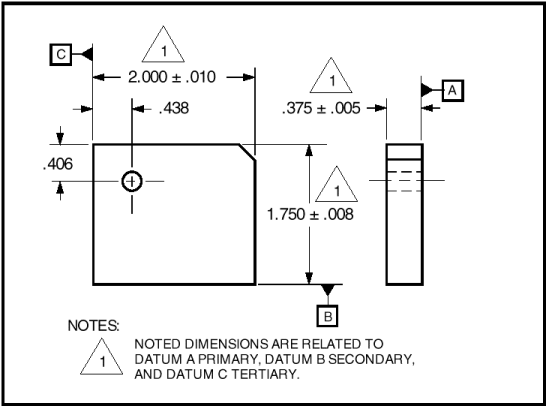

4.17. Datum_precedence_assignment
A Datum_precedence_assignment corresponds to the
specification of the order in which a datum is
established within a datum system.
NOTE — The Datum_precedence_assignment
entity is based on the Property_definition entity
of STEP Part 41 [11].
-
NOTE — On technical drawings, the precedence of a
datum within a datum system is typically specifiedin a
feature control frame. The location of the compartment
containing the letter(s) corresponding to the datum
feature(s) from which the datum is established
indicates the assigned precedence. The compartment for
the primary datum (if it exists) is immediately to the
right of the compartment containing the tolerance
value. The compartment for the secondary datum (if it
exists) is immediately to the right of the compartment
for the primary datum. Lastly, the compartment for the
tertiary datum (if it exists) is immediately to the
right of the compartment for the secondary datum.
EXAMPLE — Figure2 (b) contains a feature
control frame that specifies a datum system in which
datum A is the primary datum, datum B is the
secondary datum, and datum C is the tertiary datum.
Similarly, Fig. 2 (c) contains a feature control
frame that specifies a datum system in which datum A
is the primary datum, datum C is the secondary datum,
and datum B is the tertiary datum.
-
Attribute definitions:
assigned_to: The assigned_to attribute
specifies a Datum_usage_in_datum_system . In
essence, the Datum_usage_in_datum_system
corresponds to the datum within the context of the datum
system to which the datum precedence is assigned.
-
NOTE — A datum within the context of one datum
system may be assigned one precedence, e.g., primary,
and the same datum within the context of another datum
system may be assigned another precedence, e.g.,
secondary.
EXAMPLE — In Fig. 6, datum feature C (the end
surface of the part that is shown on the right side)
isused to establish a datum plane. The top-most
feature control frame asserts that this datum is the
secondary datum within the context of one datum
system. Furthermore, the bottom-most feature control
frame asserts that this datum is the primary datum
within the context of another datum system.
-
name: The name attribute specifies the
value of the assigned datum precedence. Valid values for
the name are PRIMARY, SECONDARY, and TERTIARY.
Inverse attribute definitions:
associate_datum_system_definition: The
associate_datum_system_definition attribute
specifies the Datum_system_definition that
corresponds to the datum system specification to which
the datum precedence is associated.
Constraints:
UR1: The combination of name and
associate_datum_system_definition shall be unique
within a population of Datum_precedence_assignment
s.
-
NOTE — UR1 corresponds to the assertion that no
two datums of a datum system shall have the same
precedence.
-
Fig. 6. Technical drawing of a hydraulic valve. This
technical drawing is a partial reproduction of a drawing
presented on page 308 in Geometric Dimensioning and
Tolerancing [14].
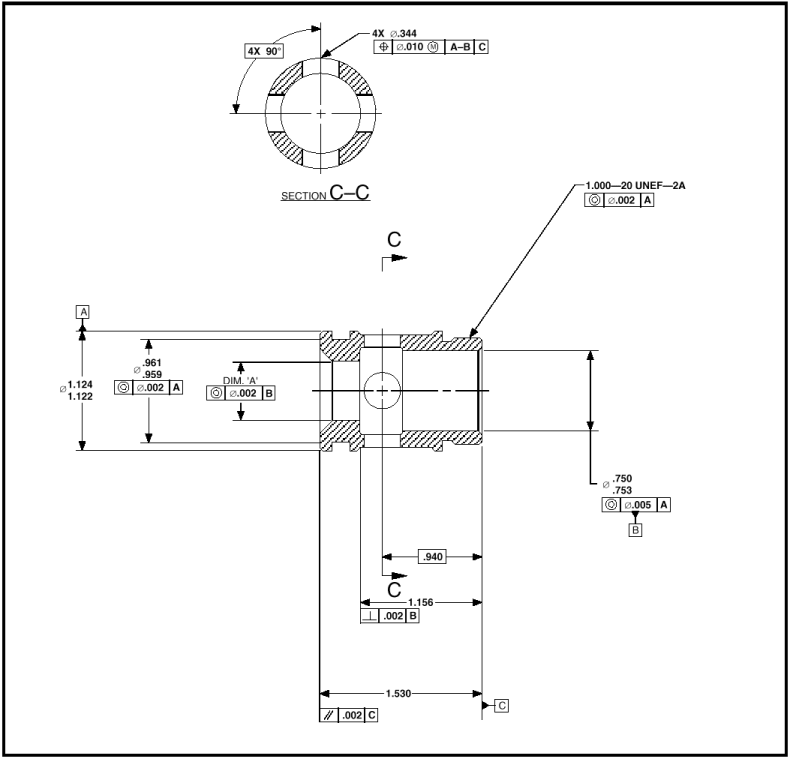

4.18. Datum_feature_material_condition_property
A Datum_feature_material_condition_property
corresponds to the specification of a material condition
property (i.e., least material requirement or
maximum material principle ) that is explicitly
applied to a datum feature within the context of a datum
system.
-
NOTE — The
Datum_feature_material_condition_property entity
is based on the Property_definition entity of
STEP Part 41 [11].
-
Attribute definitions:
applied_to: The applied_to attribute
specifies a Datum_feature_usage_in_datum_system .
In essence, the
Datum_feature_usage_in_datum_system corresponds to
the datum feature within the context of the datum system
to which the material condition property is applied.
-
NOTE — A datum feature within the context of one
datum system may have one material condition property
applied, e.g., least material requirement , and
the same datum feature within the context of another
datum system may have another material condition
property applied, e.g., maximum material
principle .
-
name : The name attribute specifies the
value by which the material condition property is known.
Valid valuesfor the name are
LEAST_MATERIAL_REQUIREMENT and MAXIMUM_MATERIAL_PRINCIPLE
(see Sec. 3 of this paper).
-
NOTE — A
Datum_feature_material_condition_property that
has a name of LEAST_MATERIAL_REQUIREMENT
corresponds to a datum feature letter followed by the
 symbol in a feature control frame of a
technical drawing, e.g.,
symbol in a feature control frame of a
technical drawing, e.g.,  (the
(the  symbol after the tolerance value is associated with the
toleranced feature and its representation is not within
the scope of this paper).
symbol after the tolerance value is associated with the
toleranced feature and its representation is not within
the scope of this paper).
NOTE — A
Datum_feature_material_condition_property that
has a name of MAXIMUM_MATERIAL_PRINCIPLE
corresponds to a datum feature letter followed by the
 symbol in a feature control frame of a
technical drawing, e.g.,
symbol in a feature control frame of a
technical drawing, e.g.,  (the
(the
 symbol after the tolerance value is
associated with the toleranced feature and its
representation is not within the scope of this
paper).
symbol after the tolerance value is
associated with the toleranced feature and its
representation is not within the scope of this
paper).
NOTE — It shall be understood that the
regardless of feature size principle (see Sec.
3 of this paper) shall be in effect in cases where
the datum feature is a feature of size (see Sec. 3 of
this paper) and a
Datum_feature_material_condition_property is
not specified.
-
Inverse attribute definitions:
associate_datum_system_definition : The
associate_datum_system_definition attribute
specifies the
Datum_system_definition_with_material_conditions
that corresponds to the datum system specification to
which the material condition property is associated.

4.19. Geometric_tolerance_with_specified_datum_system
The
Geometric_tolerance_with_specified_datum_system
entity is not completely defined here, as it is not
within the scope of this paper. However, the
referenced_datum_system_definition attribute of
this entity is defined to illustrate how the DSCDM could
be tied into a larger GD&T; data model.
-
NOTE — The
Geometric_tolerance_with_specified_datum_system
entity is based on the Property_definition
entity of STEP Part 41 [11].
-
Attribute definitions:
referenced_datum_system_definition : The
referenced_datum_system_definition attribute
specifies the Datum_system_definition that
corresponds to the datum system specification that is
referenced by the geometric tolerance.

4.20. Dimension_with_specified_datum_system
The Dimension_with_specified_datum_system entity
is not completely defined here, as it is not within the
scope of this paper. However, the
referenced_datum_system_definition attribute of
this entity is defined to illustrate how the DSCDM could
be tied into a larger GD&T; data model.
-
NOTE — The
Dimension_with_specified_datum_system entity is
based on the Property_definition entity of STEP
Part 41 [11].
NOTE — While the data modeled with the
Datum_system_definition entity is associated
almost exclusively with geometric tolerances, clause
4.4 of ASME Y 14.5M [4] describes the usage of this
data with linear and angular dimensions. The
Dimension_with_specified_datum_system entity
is shown in Fig. 1 to illustrate this usage.
EXAMPLE — The three linear dimensions presented
in Fig. 5 reference NOTE 1. This note is a
specification for a datum system that specifies that
the primary datum is established from datum feature
A, the secondary datum is established from datum
feature B, and the tertiary datum is established from
datum feature C.
-
Attribute definitions:
referenced_datum_system_definition : The
referenced_datum_system_definition attribute
specifies the
Datum_system_definition_without_material_conditions
that corresponds to the datum system specificationthat is
referenced by the dimension.

5. Part 47 Datum System Related Model
A pseudo EXPRESS-G diagram of the datum system related
portion of the Part 47 model is presented inFig. 7. The
term“pseudo”is used because non-standard
EXPRESS-G is employed to indicate the constraints placed
on the Datum_target , Datum_feature , and
Datum entities (e.g., the model shows three
Shape_aspect_relationship entities). Additionally,
the EXPRESS-G diagram does not show that the
Datum_target , Datum_feature , and
Datum entities are subtypes of the
Shape_aspect entity of STEP Part 41[11].
Fig. 7. Pseudo EXPRESS-G diagram of datum system related
entities of STEP Part 47 [2].
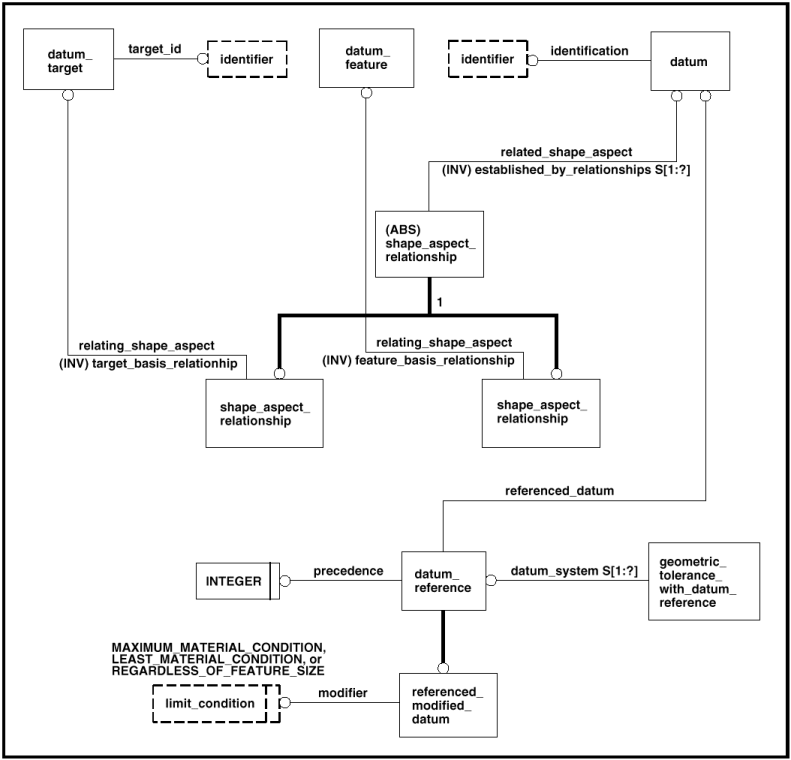
The definitions of the entities shown in Fig. 7 are
provided in Tables 1 – 6. These definitions are
taken from STEP Part 47 [2].
-
NOTE — The actual EXPRESS declarations of these
entities have not been included in the definitions
given in Tables 1 – 6, as they are not necessary
to the understanding of the concepts presented in this
paper.
NOTE — The clause and figure numbers specified
within Tables 1 – 6 are from STEP Part 47 and
should not be confused with the clause and figure
numbers of this paper.
-
Table 1. Definition of Datum from STEP Part 47 [2].
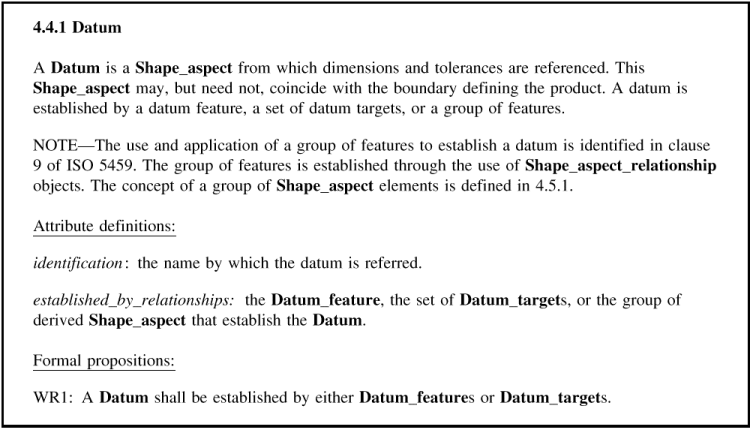
Table 2. Definition ofDatum_featurefrom STEP Part 47 [2].

Table 3. Definition of Datum_target from STEP Part 47
[2].
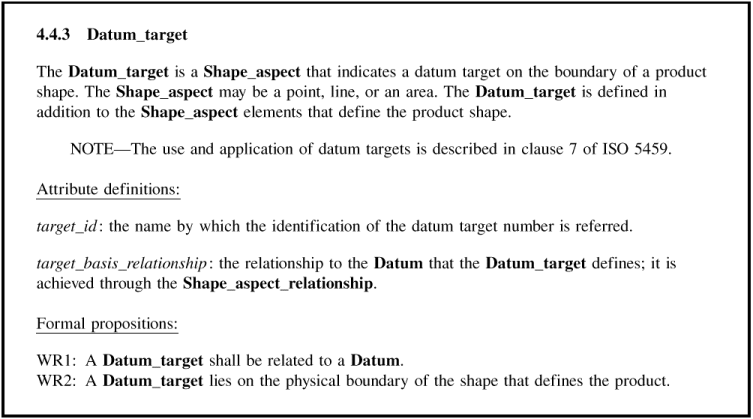
Table4. Definition ofDatum_referencefrom STEP Part 47
[2].

Table 5. Definition ofReferenced_modified_datumfrom STEP
Part 47 [2].
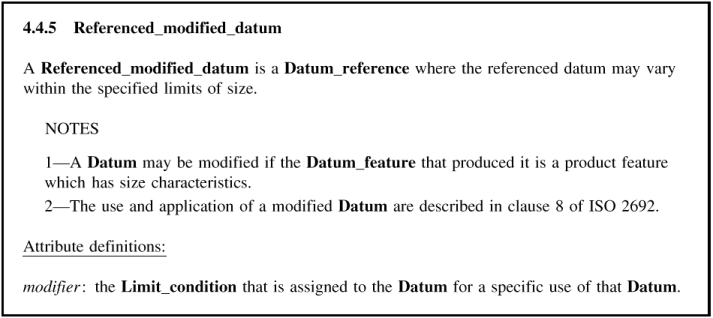
Table 6. Definition
ofGeometric_tolerance_with_datum_reference from STEP Part
47 [2].
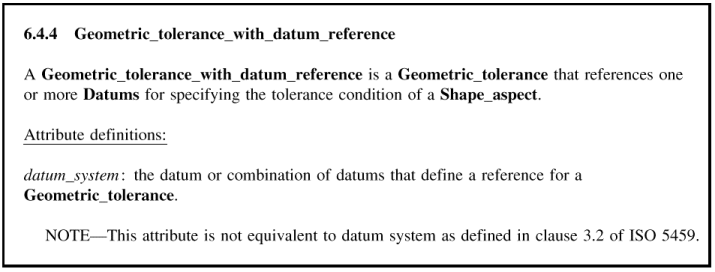
-
NOTE — The definition of the
Geometric_tolerance entity of which the
Geometric_tolerance_with_datum_reference entity
is a subtype is not shown here, as it is not within the
scope of this paper.
-

6. The DSCDM Compared to the Part 47 Model
This section discusses the differences between the DSCDM
and portions of the model presented in STEP Part 47 [2]
that are related to datums. Inasmuch as STEP Part 47 is
an integrated generic resource, it should notnecessarily
be as specialized as the DSCDM. Still, it is useful to
make certain comparisons between these two models to
observe how they differ in representing the datum related
concepts presented in some of the GD&T drawing-based;
standards. It is particularly useful to note cases that
cannot be clearly represented with the Part 47 model and
in which the deficiency is not due to the generic nature
of the Part 47 model.
-
NOTE — The STEP architecture is such that STEP
application protocols may specialize entities from the
STEP integrated generic resources. However,
deficiencies in entities of the type mentioned above
will only be passed on to the STEP application
protocols that incorporate them.
EXAMPLE — A STEP application protocol that
incorporates the Datum_feature entity from
STEP Part 47 will not be able to support multiple use
datum features (see Sec. 6.3).
-

6.1. Datum_system and Datum_system_definition
One of the main differences between the Part 47 model and
the DSCDM is that the Part 47 model has no entities that
are equivalent to the Datum_system and
Datum_system_definition entities of the DSCDM. Two
independent comments were submitted against the STEP Part
47 DIS [15] document indicating that the concept of datum
precedence only made sense within the context of a datum
system. Additionally, one of those comments also
indicated that the modifier for the Datum_reference only
made sense in the context of a datum system. Concurring
with those comments, the Datum_system and
Datum_system_definition entities were incorporated
within the DSCDM.

6.2. Ambiguous Datum Feature Identification
In the DSCDM the identification attribute is on
the Datum_feature entity; in contrast, in the Part
47 model the identification attribute is on the
Datum entity. In practice, it is the datum feature
to which an identifier is assigned. ASME Y14.5M [4]
states,“Each datum feature of a part requiring
identification shall be assigned a different
letter.” Furthermore, datums associated with datum
systems are identified by the datum features from which
they are established. In cases in which a datum is
established from a single datum feature, the location of
the identification attribute may seem moot,
because if the identification attribute is placed
on the Datum entity, the name of the associated
datum feature could easily be derived. However, in cases
in which a datum is established from more than one datum
feature, the Part 47 model produces ambiguous results
because it is impossible to determine the name of the
datum features from the value of the
identification attribute on a Datum .The
DSCDM does not have this ambiguity, as the
identification attribute is on the
Datum_feature entity.
-
EXAMPLE — The
 feature control
frame of the position tolerance in Fig. 6 indicates
that the primary datum is established from datum
feature A in conjunction with datum feature B. If the
Part 47 model was used to describe this requirement,
the identification attribute of the Datum
entity would have a value of“A – B.”
However, it would be unclear as to which datum feature
is identified as A and which datum feature is
identified as B.
feature control
frame of the position tolerance in Fig. 6 indicates
that the primary datum is established from datum
feature A in conjunction with datum feature B. If the
Part 47 model was used to describe this requirement,
the identification attribute of the Datum
entity would have a value of“A – B.”
However, it would be unclear as to which datum feature
is identified as A and which datum feature is
identified as B.
NOTE — As the Datum and
Datum_feature entities in the Part 47 model
are subtypes of the Shape_aspect entity of
STEP Part 41 [11], they both inherit a name
attribute. However, as a Datum_feature
corresponds to an actual feature of a part it is
likely that the name attribute will not be
available for the datum feature identifying letter
because it will likely be used for another purpose
(e.g., the name given to a feature prior to its
promotion to a datum feature). Furthermore, as datums
are identified solely for GD&T; purposes it is
likely that the inherited name attribute on
the Datum entity would be available, thereby
making the identification attribute on the
Datum entity not only misplaced but redundant.
-

6.3. Multiple Use Datum Features
The Part 47 model fails to account for the fact that a
datum feature may be used to establish multiple datums,
whereas the DSCDM does account for this fact. In the Part
47 model, the feature_basis_relationship attribute
and WR1 on the Datum_feature entity specify that a
Datum_feature shall be related to exactly one
Datum . On the other hand, in the DSCDM the
inverse datum_feature_usages attribute on the
Datum_feature entity constrains the number of
Datum s that shall be established from a
Datum_feature to one or more.
-
EXAMPLE — The technical drawing presented in Fig.
6 illustrates how a datum feature may be used to
establish multiple datums. This figure shows that datum
feature A (the outer most cylindrical surface) is used
to establish the primary datum (a center axis) of the
datum system specified by three concentricity
tolerances (e.g.,
 ). Also, Fig. 6
shows that datum feature B (the inner hole surface on
the right side) is used to establish the primary datum
(another center axis) of the datum system specified by
a concentricity tolerance and a perpendicularity
tolerance (i.e.,
). Also, Fig. 6
shows that datum feature B (the inner hole surface on
the right side) is used to establish the primary datum
(another center axis) of the datum system specified by
a concentricity tolerance and a perpendicularity
tolerance (i.e.,  , and
, and  ).
Furthermore, both datum features Aand B are used once
again to establish the primary datum (yet another
center axis) of the datum system specified by the
position tolerance (i.e.,
).
Furthermore, both datum features Aand B are used once
again to establish the primary datum (yet another
center axis) of the datum system specified by the
position tolerance (i.e.,  ). As the Part 47
model limits the number of datums that may be
established from a datum feature to one, this situation
cannot be represented with the Part 47 model.
). As the Part 47
model limits the number of datums that may be
established from a datum feature to one, this situation
cannot be represented with the Part 47 model.
-

6.4. Multiple Use Datum Targets
The Part 47 model fails to account for the fact that a
datum target may be used to establish multiple datums,
whereas the DSCDM does account for this fact. In the Part
47 model the target_basis_relationship attribute
and WR1 on the Datum_target entity specify that a
Datum_target shall be related to exactly one
Datum . On the other hand, the DSCDM does not
specify a direct relationship between a
Datum_target and a Datum . Instead,in the
DSCDM the relationship between a Datum_target and
a Datum is specified indirectly via the
Datum_target_set entity and the two relationship
entities Datum_target_usage_in_datum_target_set
and Datum_feature_usage_in_datum . In the DSCDM
the constraints on Datum_target and
Datum_feature correspond to the assertion that a
datum target shall be used in at least one datum target
set and because a datum target set is a type of datum
feature, the datum target set shall be used to establish
at least one datum. The technical drawing presented in
Fig. 8 shows nine datum targets (datum target points are
indicated by the × symbols), six of which are used
to establish multiple datums.
-
EXAMPLE — The datum target point in Fig. 8 that
is connected to the
 and
and  datum target frames is associated with two datum target
sets, F and G, each of which is used to establish a
separate datum. As the Part 47 model limits the number
of datums that may be established from a datum target
to one, this situation cannot be represented with the
Part 47 model.
datum target frames is associated with two datum target
sets, F and G, each of which is used to establish a
separate datum. As the Part 47 model limits the number
of datums that may be established from a datum target
to one, this situation cannot be represented with the
Part 47 model.
-
Fig. 8. Technical drawing illustrating multiple use of
datum targets. This technical drawing is a reproduction
of a drawing presented on page 265 in Geo-metrics
IIIm [8].
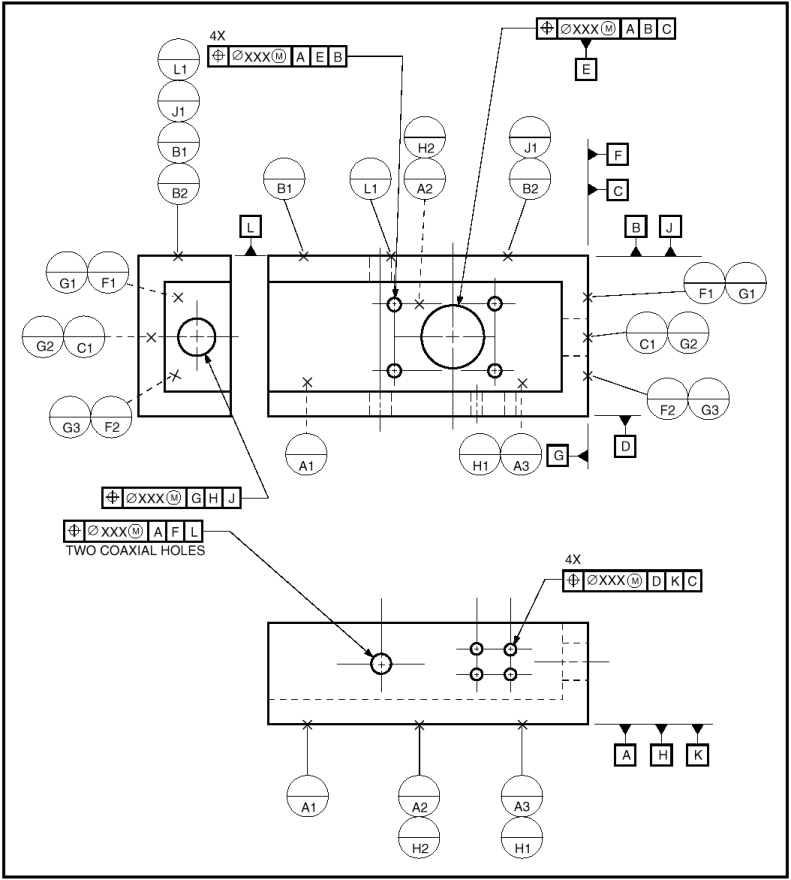

6.5. Datum Target Sets
In the DSCDM, a Datum_target_set is a type of
Datum_feature . The Part 47 model has no entity
that is equivalent to the Datum_target_set entity.
Furthermore, the Part 47 model prevents the
Datum_feature entity or a specialization (i.e.,
subtype) of it to serve as a set of datum targets. That
is, in the Part 47 model the attributes
target_basis_relationship
andfeature_basis_relationship on the
Datum_target and Datum_feature entities,
respectively, in association with WR1 on each of these
entities, prevent a Datum_target from beingrelated
to a Datum_feature via a
Shape_aspect_relationship .
-
NOTE — On technical drawings, datum target frames
are used to group datum targets into datum target sets.
EXAMPLE — In the technical drawing presented in
Fig. 4, the three datum target points (×
symbols are used to indicate datum target points)
that are connected to the  ,
,  and
and  datum target frames make updatum
target set A. Additionally, the two datum target
areas (hatched regions are used to indicate datum
target areas) that are connected to the
datum target frames make updatum
target set A. Additionally, the two datum target
areas (hatched regions are used to indicate datum
target areas) that are connected to the  and
and  datum target frames constitute datum
target set B. Also, the datum target point that is
connected to the
datum target frames constitute datum
target set B. Also, the datum target point that is
connected to the  datum target
frame makes up datum target set C.
datum target
frame makes up datum target set C.
-

6.6. Multiple Datum Target Numbers
The Part 47 model fails to account for the fact that
multiple datum target numbers may be associated with a
datum target, whereas the DSCDM does account for this
fact. In the Part 47 model, the definition for the
target_id attribute on the Datum_target
entity indicates that the use of this attribute is to
associate adatum target number with a datum target.
However, the placement of this attribute on the
Datum_target entity only allows a single datum
target number to be associated with a datum target, which
is not surprising as the Part 47 model only allows a
datum target to be associated with a single datum. On the
other hand, in the DSCDM the placement of the
datum_target_number attribute on the
Datum_target_usage_in_datum_target_set entity
permits a different datum target number to be assigned to
each usage of a datum target in a datum target set.
-
NOTE — On technical drawings, datum target frames
are used to group datum targets into datum target sets.
Additionally, datum target frames specify datum target
numbers by which the datum targets are identified
within the datum target sets.
The technical drawing presented in Fig. 8 shows
several instances in which a datum target is
identified by multiple datum target numbers, one for
each usage of a datum target in a datum target set.
EXAMPLE — The datum target point in Fig. 8 that
is connected to the  and
and  datum target frames isassociated with two datum
targets sets, C and G. This datum target is
identified by a datum target number of
“1” when it is associated with datum
target set C and is identified by a datum target
number of“2”when it is associated with
datum target set G.
datum target frames isassociated with two datum
targets sets, C and G. This datum target is
identified by a datum target number of
“1” when it is associated with datum
target set C and is identified by a datum target
number of“2”when it is associated with
datum target set G.
-

6.7. Composite Datum Features
A composite datum feature is a datum feature that is
composed of other features. Figures 9 and 10 depict two
examples of composite datum features.
Fig. 9. Depiction of a composite datum feature that is
composed of two opposing planar features.This figure is a
reproduction of FIG. 4-14 of ASME Y14.5M [4].
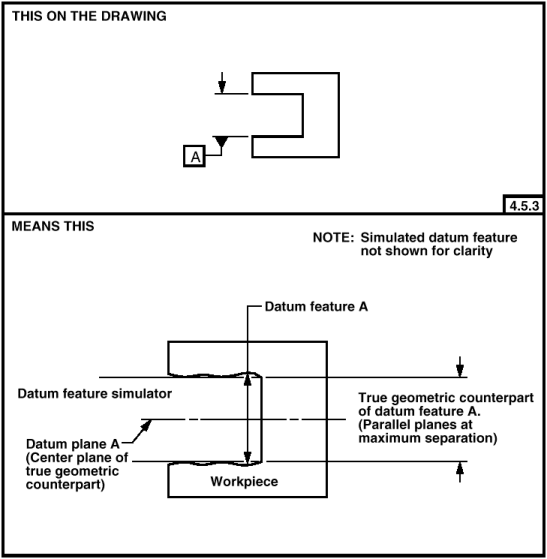
Fig. 10. Depiction of a composite datum feature that is
composed of four cylindrical features (holes). This
figure is a reproduction of FIG. 4-22 of ASME Y14.5M [4].
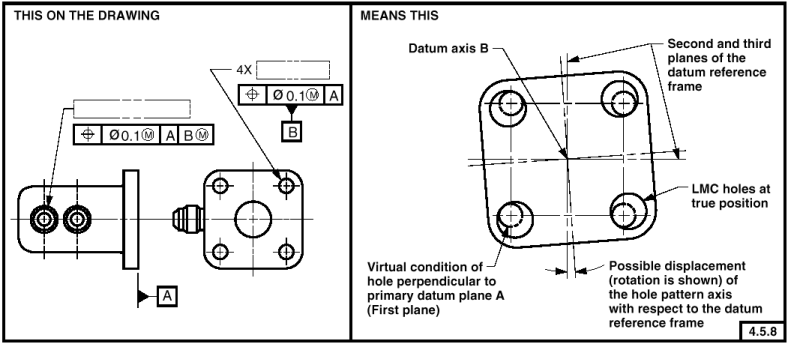
Neither the Part 47 model nor the DSCDM have an explicit
entity that corresponds to a composite datum feature.
However, it is of interest to examine how composite datum
features may be represented using these two models.
The model presented in STEP Part 47 has a
Composite_shape_aspect entity, the intent of which
is to group Shape_aspects for a purpose. At first
glance this seems like a perfect match — a
Shape_aspect that is a Datum_feature as
well as a Composite_shape_aspect could represent a
composite datum feature. This usage of
Composite_shape_aspect is even mentioned in a note
in clause 4.4.1 of STEP Part 47 [2] (see Table 1 of this
paper). Unfortunately, the
feature_basis_relationship inverse attribute on
the Datum_feature entity requires that a
Datum_feature be specified as the
relating_shape_aspect by exactly one
Shape_aspect_relationship . Conversely, the
component_relationships inverse attribute on the
Composite_shape_aspect entity requires that a
Composite_shape_aspect be specified as the
relating_shape_aspect by two or more
Shape_aspect_relationships (these
Shape_aspect_relationships relate the
Composite_shape_aspect with the
Shape_aspects from which it is composed). This
conflict between the two inverse attributes prohibits a
Shape_aspect from being both a
Datum_feature and a Composite_shape_aspect
. Figure 11 is a pseudoEXPRESS-G diagram illustrating
this conflict.
Though the DSCDM does not explicitly address the
composite datum feature, the DSCDM is constructed
suchthat composite datum features may be addressed by
incorporating the DSCDM into a more complete GD&T
model; that has an entity similar to the
Composite_shape_aspect entity or by further
specializing the Datum_feature entity .
-
NOTE — Appendix C presents one way in which
composite datum features may be addressed by a GD&T
model; that incorporates the DSCDM.
-
In summary, the DSCDM is designed such that it may be
extended to address composite datum features, whereas the
Part 47 model is constructed such that even the entities
that it indicates should be used to address composite
datum features cannot be used for this purpose.
Fig. 11. Pseudo EXPRESS-G diagram illustrating why a
Shape_aspect from STEP 47 cannot be both a
Datum_feature and a Composite_shape_aspect
.


6.8. Datum Precedence Assignment
The Part 47 model and the DSCDM differ in two ways with
respect to the assignment of datum precedence.
The first difference is that datum precedence is more
rigorously defined in the DSCDM than in the Part 47
model. For example, the only constraint associated with
the precedence attribute in the Part 47 model is
that it must be an integer value that is greater than
zero. However, the DSCDM has several constraints that
ensure that the datums of the datum system have a valid
precedence value assigned to them. For example, the UR1
constraint on the Datum_precedence_assignment
entity corresponds to the assertion that no two datums of
a datum system shall have the same precedence value. This
lack of rigor in the Part 47 model may be attributed to
the fact that STEP Part 47 [2] is a generic integrated
resource and as such is not necessarily intended to fully
define the requirements.
The second difference is that in the Part 47 model the
precedence attribute on the Datum_reference
entity isused to assign a precedence directly to a
Datum , as opposed to in the DSCDM where the
assigned_to attribute on the
Datum_precedence_assignment entity is used to
assign a precedence to a
Datum_usage_in_datum_system . Inasmuch as the
Datum_usage_in_datum_system entity corresponds toa
datum in the context of a datum system, the DSCDM
structure asserts that the precedence is assigned to a
datum in the context of a datum system.
-
NOTE — Two of the comments (neither of which were
the author's) submitted against the STEP Part 47 DIS
[15] document indicated that the concept of datum
precedence only made sense within the context of a
datum system. Also, note the wording in clause 2.4.4.2
of STEP Part 41 [11] (see Appendix B of this paper)
that describes when a Property_definition is
applied to a Shape_aspect_relationship
,“It applies to . . . an element of the shape in
the context of another element of the shape . .
..”These two details influenced the structure of
the DSCDM with respect to what entity is specified by
the assigned_to attribute of the
Datum_precedence_assignment entity.
-

6.9. Modifiers and Consistency with ASME Y14.5M
The Part 47 model is inconsistent with ASME Y14.5M [4]
with regard to modifiers, whereas the DSCDM is consistent
with ASME Y14.5M in this regard. Clause 4.5.7 of ASME
Y14.5M states,“Where more than one datum feature is
used to establish a single datum, the appropriate datum
reference letters and associated modifiers, separated by
a dash, are entered in one compartment of a feature
control frame.”This statement indicates that
modifiers are associated with datum features (see Fig.
12). However, in the Part 47 model the
Referenced_modified_datum entity is used to
associate modifiers with datums, not datum features. On
the other hand, in the DSCDM the
Datum_feature_material_condition_property entity
is used to associate modifiers with datum features. (This
association is made indirectly through the
Datum_feature_usage_in_datum_system entity, as the
DSCDM asserts that a modifier is applied to a datum
feature in the context of a datum system.)
-
NOTE — The term datum reference letter is
somewhat of a misnomer, as a datum reference
letter actually refers to a datum feature.
EXAMPLE — In Fig. 12, the  symbol
following the letter“A”in the feature
control frame associates the maximum material
principle with datum feature A. Likewise, the
symbol
following the letter“A”in the feature
control frame associates the maximum material
principle with datum feature A. Likewise, the
 symbol following the
letter“B” in the feature control frame
associates the maximum material principle with
datum feature B.
symbol following the
letter“B” in the feature control frame
associates the maximum material principle with
datum feature B.
-
One may argue that if modifiers are directly associated
with datums, as in the Part 47 model, they are indirectly
associated with the datum features that establish those
datums. However, this contrivance fails in cases in which
the requirements are such that all the datum features
from which a common datum is established are not to
beassociated with the same modifier.
-
NOTE — While the DSCDM supports the application
of different modifiers to the datum features of a
common datum, as is permitted in ASME Y14.5M, the
author of this paper has been unable to find examples
of this situation in standards or reference books.
Therefore, it is believed that occurrences of this case
are probably extremely limited.
-
Fig. 12. Technical drawing illustrating the application
of modifiers to both datum features that establish a
common datum. This technical drawing is a reproduction of
FIG. 4-19 of ASME Y14.5M [4].


6.10. Dimensions and Datum System Specifications
In the DSCDM the
Dimension_with_specified_datum_system corresponds
to a type of dimension thatreferences a datum system
specification. The Part 47 model has no entity that is
equivalent to the
Dimension_with_specified_datum_system entity.
-
NOTE — The
Dimension_with_specified_datum_system entity is
not completely defined in this paper, as a discussion
of dimensions is outside its scope.
NOTE — Clause 4.4 of ASME Y14.5M [4] describes
dimensions that reference datum system
specifications.
EXAMPLE — The technical drawing presented in
Fig. 5 shows three linear dimensions that reference a
datum system specification.
-

6.11. Datums Without Datum Features or Datum Targets
The Part 47 model cannot be used to represent datums that
are not directly established from datum features or datum
targets. This is because the attributes and rules on the
Datum , Datum_feature , and
Datum_target entities assert that each datum shall
be established from one or more datum features or datum
targets, that each datum feature shall be used to
establish a single datum, and that each datum target
shall be used to establish a single datum. In contrast,
the DSCDM only requires that the relationship between the
datum feature(s) from which a datum is established be
specified for those datums that are used to establish a
datum system. That is, for adatum not used to establish a
datum system (some datums may just be the origin of one
or more dimensions), the DSCDM does not require the
corresponding Datum to be related to a
Datum_feature via the
Datum_feature_usage_in_datum entity.
-
EXAMPLE — In Fig. 13 (a) the position tolerance
references a datum system that is established from two
datums: the datum plane [indicated as the“First
datum plane”in Fig. 13 (b)] that is established
from datum feature K and the datum axis [indicated as
the“Datum axis”in Fig. 13 (b)] that is
established from datum feature M. However, two other
datum planes (indicated as the“Second datum
plane” and“Third datum plane”) also
exist and serve as origins for the dimensions that
locate the four holes. As there are four datums and
only two datum features, the situation shown in Fig. 13
cannot be represented using the Part 47 model (recall
the formal propositions on the Datum ,
Datum_feature , and Datum_target entities
in the Part 47 model). However, as the DSCDM does not
require a Datum to be related to either a
Datum_feature or a Datum_system , this
situation can be represented using the DSCDM.
NOTE — Although the datum planes that are
labeled “Second datum
plane”and“Third datum plane” in
Fig. 13 are not part of a datum system, they are part
of a datum reference frame. Datum reference frames
are not modeled in the DSCDM (datum reference frames
are discussed in Appendix D of this paper). However,
because the DSCDM does not require a datum to be part
of a datum system and does notrequire a datum to be
established from a datum feature, the DSCDM may be
incorporated into a larger model that does include
datum reference frames.
-
Fig. 13. Example of datums not directly established from
datum features.This figure is a reproduction of FIG. 4
– 5 of ASME Y14.5M [4].
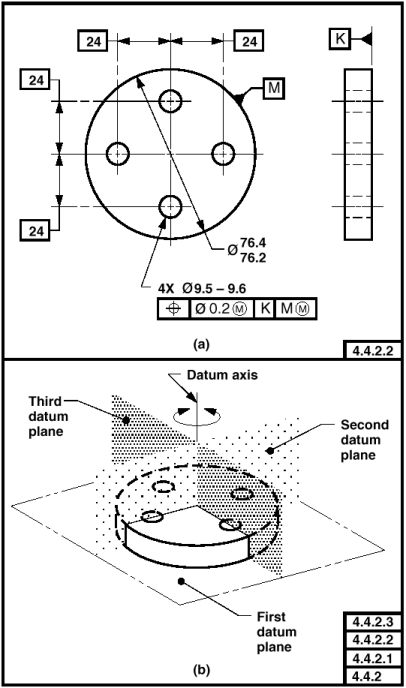

7. Conclusions
This paper has presented a data model (the DSCDM) that
covers the concepts of datum systems, datums, datum
features, and datum targets. Furthermore, for comparison
purposes, this paper has presented the datum
relatedportions of the data model given in STEP Part 47
[2]. In presenting the DSCDM, this paper has used
numerous diagrams and examples from existing GD&T;
drawing-based standards and associated reference books.
These diagrams and examples not only provided assistance
in explaining the DSCDM but also provided a set of test
cases by which the quality of the DSCDM and the Part 47
model were evaluated. This evaluation demonstrated the
robustness of the DSCDM and the brittleness of the Part
47 model. Accordingly, it is hoped that the DSCDM may
serve as a starting point for the development of more
comprehensive GD&T; data models, thereby enabling the
electronic exchange of GD&T; data among the design,
manufacturing, and inspection divisions of an enterprise.


As the data models in this paper are presented in
EXPRESS-G notation, this overview is provided to aid
those who may be unfamiliar with EXPRESS-G.
Data models formally define data objects and
relationships among data objects for a domain of
interest. Some typical applications of data models
include supporting the development of databases and
enabling the exchange of data for a particular area of
interest.
-
EXAMPLE — The data model presented in Fig. A.1
could be used to specify the requirements of a database
for an audio compact disc (CD) collection.
-
Data models are specified in a data modelling language.
EXPRESS is a data modelling language defined inISO
10303-11, the EXPRESS Language Reference Manual
[3]. EXPRESS-G is a graphical notation that supports a
subset of the EXPRESS language. One of the advantages of
using EXPRESS-G over EXPRESS is that the structure of a
data model can be presented in a more understandable
manner. A disadvantage of EXPRESS-G is that complex
constraints cannot be formally specified. Figure A.2
depicts the symbols used in the EXPRESS-G notation. The
meanings of these symbols are listed below.

A.1. Entity Data Type Symbol
Entity Data Type Symbol: An entity data type symbol [see
Fig. A.2 (A)] represents a real or conceptual object of
interest.
-
EXAMPLE — The Person entity in Fig. A.1
represents a person (or at least the essence of a
person relevant to an audio CD database).
-

A.2. Attribute Symbol
Attribute Symbol: An attribute symbol [see Fig. A.2 (F)]
represents a property of an entity. An attribute
establishes a relationship between two entities or
between an entity and a value.
-
EXAMPLE — The title_of_CD attribute on the
Audio_CD entity in Fig. A.1 represents the title
of an audio CD.
NOTE — The direction of the relationship is
towards the bubble. However, there is also a
relationship in the opposite direction. This inverse
relationship is implicit unless explicitly specified
with an inverse attribute.The cardinality of the
implicit inverse relationship is zero or more.
Explicit inverse attributes are generally specified
to support EXPRESS rules or to restrict the
cardinality to something other than zero or more. On
EXPRESS-G diagrams the inverse attribute name is
preceded by“(INV).”
EXAMPLE — The duration_ofinverse
attribute on the Duration entity in Fig. A.1
indicates that a Duration must be specified as
the track_length of exactly one
Music_track . This corresponds to the
assertion that a duration can only exist if it is
specified as the track length of a music track.
NOTE — Attributes and optional attributes may
be aggregates. Types of aggregates defined in the
EXPRESS language include arrays, bags, lists, and
sets. Attributes that are arrays, bags, lists, or
sets are denoted on EXPRESS-G diagrams by placing the
letter“A,” “B,”
“L,”or“S,” respectively,
after the attribute name. The size of the aggregate
is indicated on the diagram within square brackets
that immediately follow the letter indicating the
aggregate type.
EXAMPLE — In Fig. A.1 the track_list
attribute on the Audio_CD entity specifies a
list of one or more (the“?” indicates
that the size of the list does not have an upper
bound) Music_track s.
-

A.3. Optional Attribute Symbol
Optional Attribute Symbol: An optional attribute symbol
[see Fig. A.2 (G)] represents a property of an entity
that need not be specified.
-
EXAMPLE — The gender attribute on the
Person entity in Fig. A.1 represents the gender
of a person. As it is an optional attribute, the gender
of a person need not be specified.
-

A.4. Supertype/Subtype Symbol
Supertype/Subtype Symbol: A supertype/subtype symbol [see
Fig. A.2 (H)] represents the relationship between an
entity that is a supertype and the entity that is its
subtype. The bubble is placed on the subtype entity.
-
EXAMPLE — In Fig. A.1 the Instrumental
entity is a subtype of the Music_track entity.
Conversely, the Music_track entity is a
supertype of the Instrumental entity.
NOTE — A subtype inherits all the attributes of
its supertype(s).
EXAMPLE — The Instrumental entity in
Fig. A.1 inherits the performers ,
recorded_on , title_of_music , and
track_length attributes from the
Music_track entity.
-

A.5. Simple Data Type Symbols
Simple Data Type Symbols: Simple data type symbols [see
Fig. A.2 (E)] represent basic values. The kinds of simple
data types that are defined in the EXPRESS language are
INTEGER, REAL, STRING, NUMBER, BOOLEAN, LOGICAL, and
BINARY. The kind of simple data type determines what
values the simple data type may take on.
-
EXAMPLE — The band_name attribute on the
Band entity in Fig. A.1 is of type STRING.
Therefore, it may take on a string value.
-

A.6. Select Data Type Symbol
Select Data Type Symbol: A select data type symbol [see
Fig. A.2 (D)] indicates that an attribute may be one of
the several types specified by the select data type.
-
EXAMPLE — The Band_or_musician_select
select data type in Fig. A.1 permits the
performers attribute on the Audio_CD
entity to take on values that are either of type
Band or of type Person .
-

A.7. Enumerated Data Type Symbol
Enumerated Data Type Symbol: An enumerated data symbol
[see Fig. A.2 (B)] indicates that values that an
attribute may take on are limited to those values
specified in an enumerated list.
-
EXAMPLE — The Gender_type enumerated data
type in Fig. A.1 may take on a value of either MALE or
FEMALE.
NOTE — The values that enumerated data types
are permitted to take on are documented in EXPRESS
models. These values are not normally shown in
EXPRESS-G diagrams. However, for readability, the
permissible values for Gender_type in Fig. A.1
have been annotated to the EXPRESS-G diagram.
-
Fig. A.1. EXPRESS-G model of an audio compact disc
collection.


A.8. Defined Data Type Symbol
Defined Data Type Symbol: A defined data type symbol [see
Fig. A.2 (C)] represents a value that is based on a
simple data type. However, defined data types have
additional semantics associated with them and may have
additional constraints placed upon them that further
limit the values they may take on.
-
EXAMPLE — The defined type Minute_value in
Fig. A.1 has a base type of INTEGER and has constraints
placed upon it requiring that the value be less than
sixty and greater than or equal to zero.
NOTE — The constraints placed on defined types
are documented in EXPRESS models. These constraints
are not normally shown in EXPRESS-G diagrams.
However, for readability, the constraints for the
defined types in Fig. A.1 have been annotated to the
EXPRESS-G diagram.
-
Fig. A.2. Symbols of the EXPRESS-G notation.
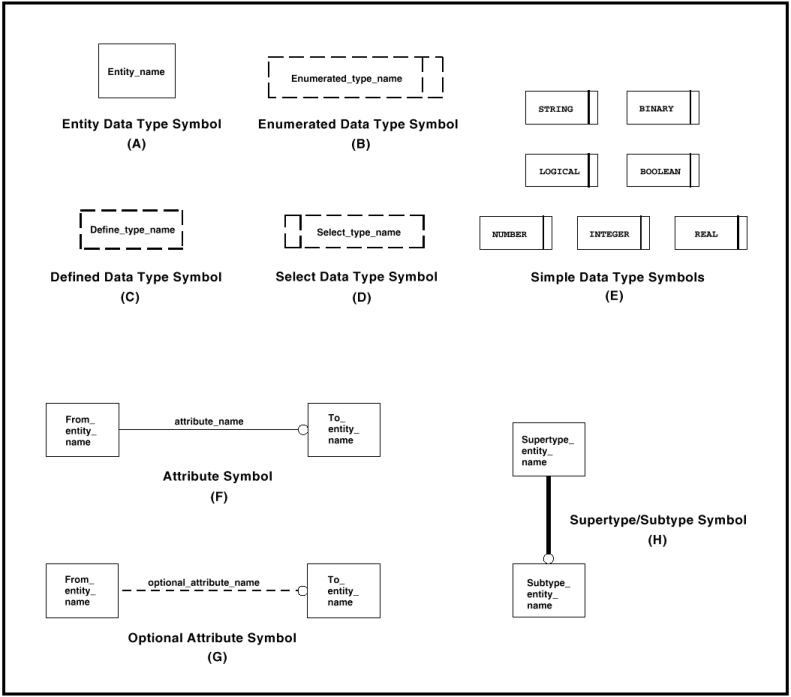
NOTE — For a more complete presentation of EXPRESS
and EXPRESS-G see ISO 10303-11 [3].

B. Underlying Data Model Structure

STEP integrated generic resource constructs are useful in
creating product data models as they define basic
concepts and the relationships between those concepts
that are relevant over many domains (e.g., the
relationship between a property definition and a shape
aspect). The underlying structure of the DSCDM is based
on four entities from the STEP integrated generic
resources. These entities are Shape_aspect ,
Shape_aspect_relationship ,
Property_definition , and
Property_definition_relationship . The
Shape_aspect , Shape_aspect_relationship ,
and Property_definition entities are from STEP
Part 41 [11]. The Property_definition_relationship
entity is from STEP Part 45 [12]. An abbreviated
EXPRESS-G diagram of these entities is shown in Fig. B.1.
Fig. B.1. EXPRESS-G diagram illustrating the STEP
integrated resources used as a basis for the DSCDM.
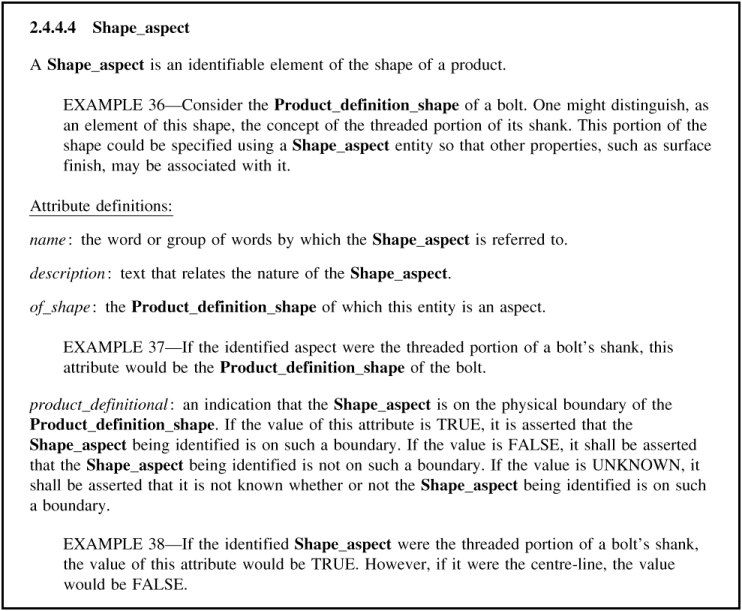
The definitions of the four entities shown in Fig. B.1
are provided in Tables B.1 – B.4. These definitions
are taken from STEP Part 41 [11] and STEP Part 45 [12].
-
NOTE — The actual EXPRESS declarations of these
entities have not been included in the definitions
given in Tables B.1 – B.4, as they are not
necessary to the understanding of the concepts
presented in this paper.
NOTE — The clause numbers specified within
Tables B.1 – B.3 are from STEP Part 41 and
should not be confused with the clause numbers of
this paper.
NOTE — The clause number specified within Table
B.4 is from STEP Part 45 and should not be confused
with a clause number of this paper.
-
Table B.1. Definition of Shape_aspect from STEP Part 41
[11].

Table B2. Definition of Shape_aspect_relationship from
STEP Part 41 [11].
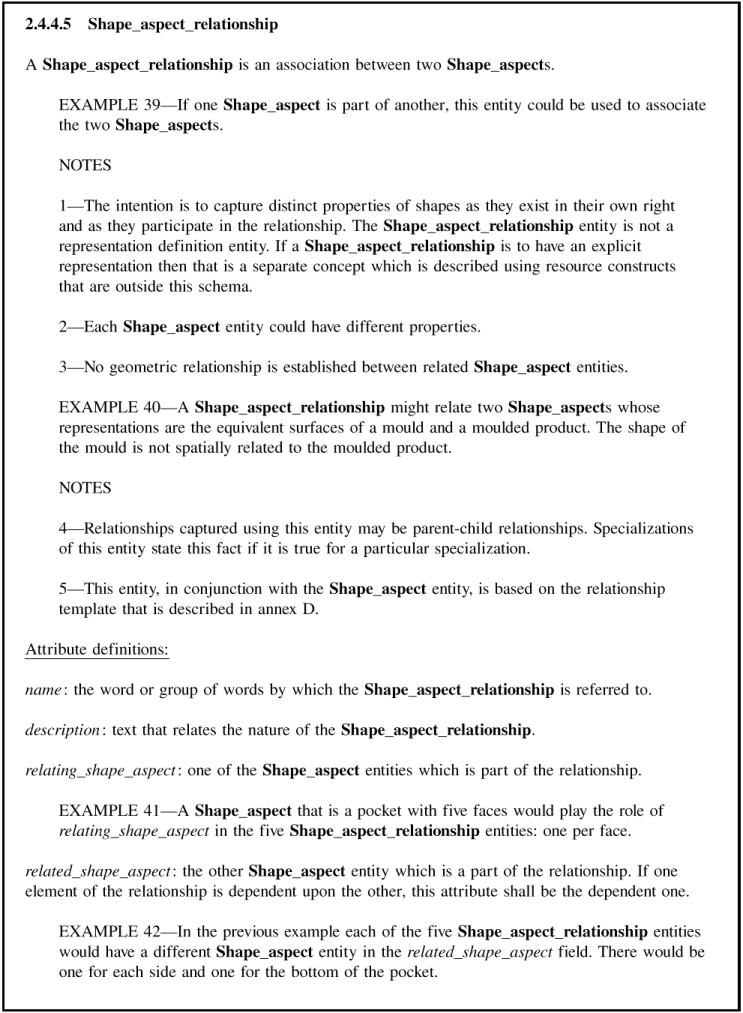
Table B.3. Definition of Property_definition from STEP
Part 41 [11].
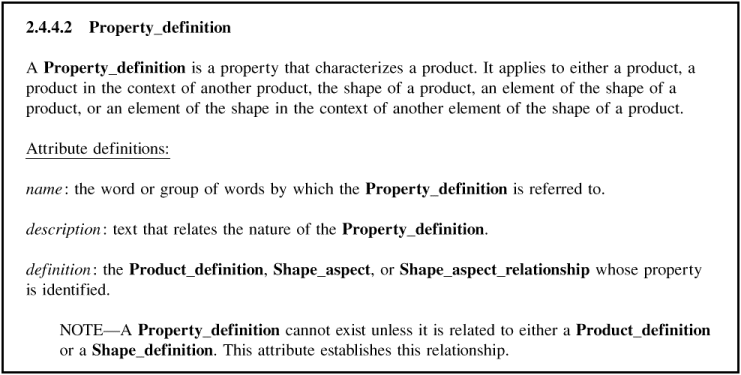
Table B.4. Definition of Property_definition_relationship
from STEP Part 45 [12].
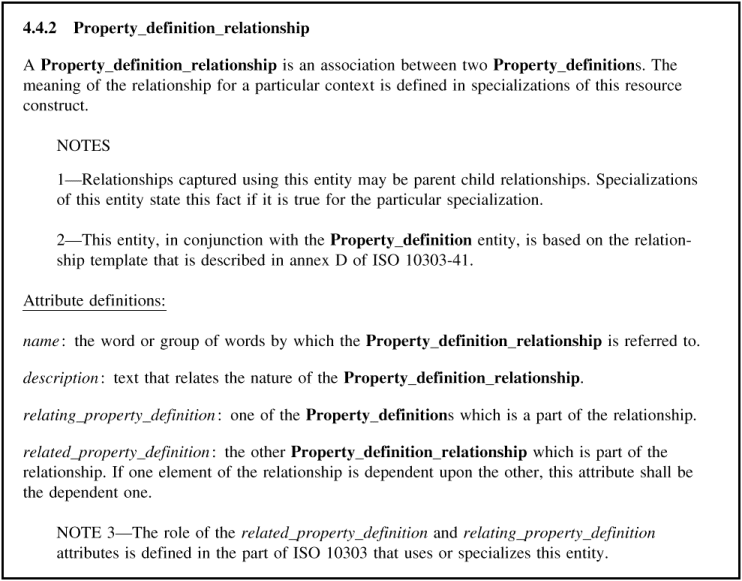
-
NOTE–The definition for the
related_property_definition attribute of the
Property_definition_relationship entity, shown
in Table B4, should read “the other
Property_definition ,” not “the
other Property_definition_relationship .”
-

C. Specializations to the DSCDM

This appendix presents possible refinements to the DSCDM.
These refinements are intended to represent possible ways
in which the DSCDM may be further specialized. Depending
on the application, the specializations may or may not be
required. Furthermore, the specializations shown here are
clearly not the only way in which the DSCDM might be
specialized.
-
NOTE — All the specializations included in this
appendix have been incorporated into the data model
that is presented in Appendix E. Also included in
Appendix E are three data populations that are based on
this extended DSCDM model.
-

C.1. Specialization of Datum
The Datum entity could be further refined to
account for the different types of datum (i.e., datum
points, datum axes, and datum planes). Figure C.1 is an
EXPRESS-G diagram illustrating this specialization.
Fig. C.1. EXPRESS-G diagram showing a possible further
specialization of the DSCDM Datum entity.
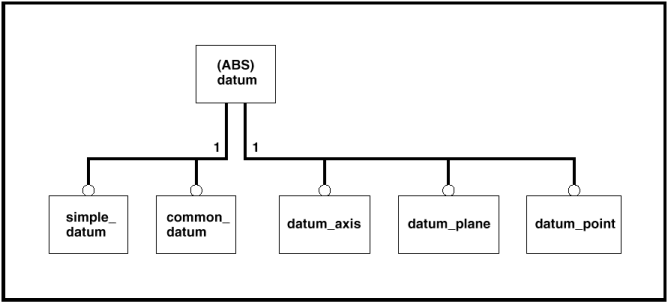
-
NOTE — There might be an additional constraint
associated with the Datum entity, requiring a
Datum to be either a Datum_axis , a
Datum_plane , or a Datum_point .
-

C.2. Specialization of Datum_feature
Typically, when one envisions the concept of feature, one
visualizes a single surface of a part. However, features
may be composed of other features. Subsequently, datum
features may be composite datum features.
-
EXAMPLE — Figures 9 and 10 show examples of
composite datum features.
-
Furthermore, features may be constituents of other
features. That is, a feature may constitute only a
portion ofa larger feature. Subsequently, datum features
may be constituent datum features.
-
NOTE — On technical drawings, a“partial
feature” is usually indicated with a chain line,
a hatched area, or both.
EXAMPLE — The chain line in Fig. C.2 indicates
that datum feature A is a constituent of the feature
that is the bottom surface of the part.
-
Fig. C.2. Diagram illustrating a constituent datum
feature. This figure is a reproduction of FIG 4-23
presented in ASME Y14.5M [4].
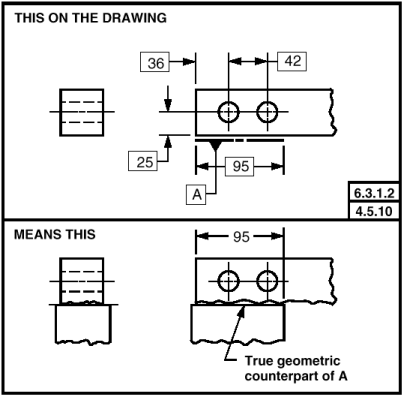
In cases in which parent-child relationships need to be
captured for composite and constituent datum features,
the Datum_feature entity may be specialized, as
shown in Fig. C.3.
-
NOTE — Entities such as Feature and
Feature_composing_relationship shown in Fig. C.3
may be subtypes of more generic entities such as
Shape_element and
Shape_element_composing_relationship ,
respectively. However, for brevity, Fig. C.3 does not
address these concepts.
NOTE — Figure C.3 does not show the various
rules that would be associated with the entities
introducedin this specialization.
EXAMPLE — A rule on the
Composite_feature entity might correspond to
the assertion that a composite feature shall not be
composed of itself.
-
Fig. C.3. EXPRESS-G diagram showing possible
specializations of the DSCDM Datum_feature and
Datum_targetentities .
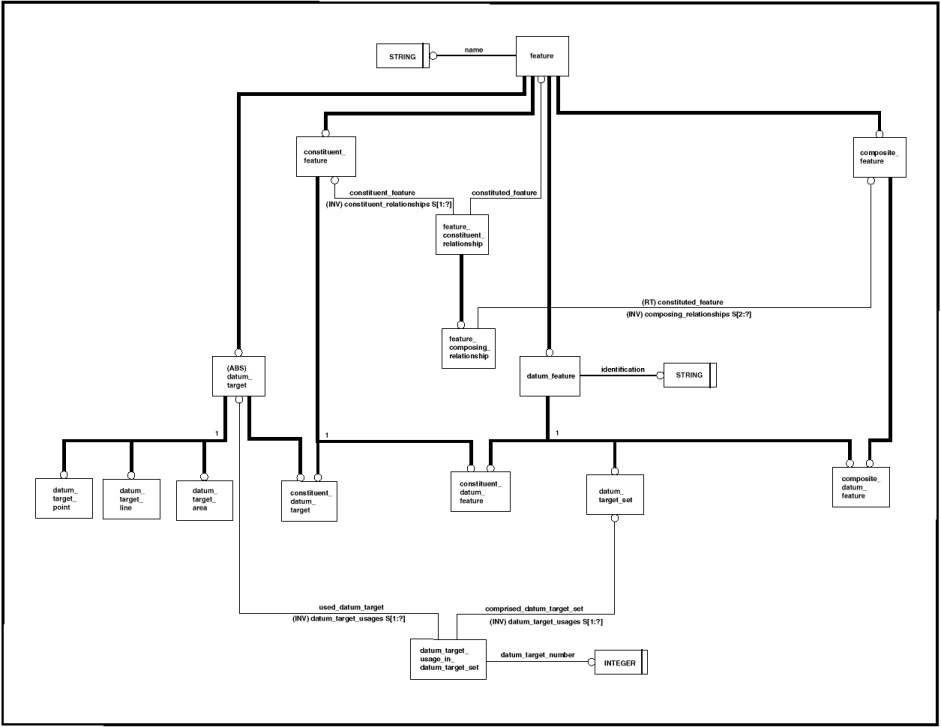

C.3. Specialization of Datum_target
The Datum_target entity could be further
specialized to account for the different types of datum
targets (i.e., datum target points, datum target lines,
and datum target areas). Additionally, the
Datum_target entity might be further specialized
to indicate when a datum target is a constituent of
another feature. Figure C.3 is an EXPRESS-G diagram
illustrating this specialization.
-
NOTE — There might be an additional constraint
associated with the Datum_target entity,
requiring a Datum_target to be either a
Datum_target_point , a Datum_target_line
, or a Datum_target_area .
NOTE — Typically, datum targets are
not“complete features;”typically, they
are constituents of other features. However, there is
no requirement that this be the case. Consequently,
any specialization of the Datum_target entity
should not require the Datum_target to be
associated with a parent entity.
EXAMPLE — The datum targets shown in the
technical drawing presented in Fig. C.4 are
“complete features.”
-
Fig. C.4. Technical drawing illustrating datum targets
that are“complete” features.”This
figure is a reproduction of a drawing presented on page
260 in Geo-metrics IIIm [8].
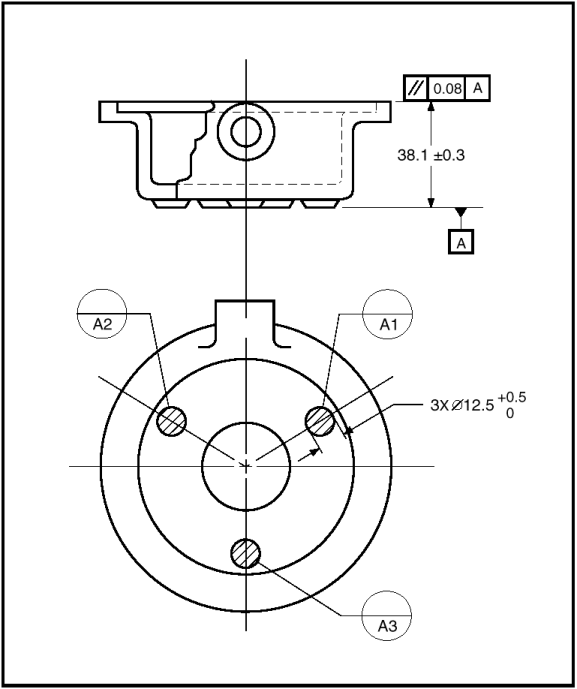

D. Datum Reference Frame vs Datum System

This appendix discusses the difference between a datum
reference frame and a datum system.
-
NOTE — The definition of datum reference frame is
given in Sec. 3 of this paper.
-
Though the concept of datum reference frame is not
modeled in the DSCDM (as it is outside the scope of this
paper), it is important to understand how a datum
reference frame differs from a datum system. While both
datum reference frames and datum systems consist of
datums (and some datums may be simultaneously in both
datum systems and datum reference frames), the
constraints placed upon the datums of a datum reference
frame differs from the constraints placed upon the datums
of a datum system. That is, datums of a datum system have
sequential constraints (i.e., datum precedence) placed
upon them. By contrast, datums of a datum reference frame
have positional constraints placed upon them (e.g., the
datum planes of a datum reference frame are always
mutually perpendicular).
-
NOTE — There is no requirement that the datum
planes of a datum system be mutually perpendicular.
-
In other words, a datum system specifies the order in
which the datums are established within the datum system,
and a datum reference frame specifies the positional
relationship among the datums of the datum reference
frame. Figure D.1 shows the inter-relationship among the
datums of a datum reference frame.
Fig. D.1. Illustration of a datum reference frame. This
figure is a reproduction of FIG. 4-1 of ASME Y14.5M [4].
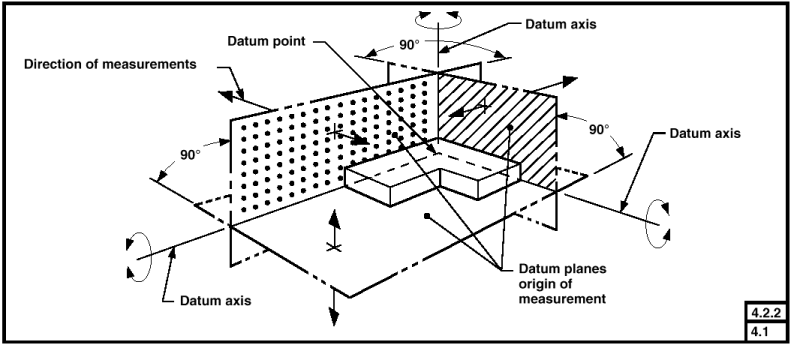
-
NOTE — The author's interpretation of datum
reference frame is slightly different from ASME Y14.5M
[4].A sentence in clause 4.2.2.2 of ASME Y14.5M states
that“any difference in the order of precedence or
in the material conditions of any datum features
referenced in multiple feature control frames requires
different datum simulation methods and, consequently,
establishes a different datum reference frame.”
The author of this paper agrees with the requirement
for different simulation methods. However, he believes
this is because of the different datum systems. From
the“data” standpoint the datums of a datum
reference frame still have the same interrelational
positional requirements no matter what their
precedence. Therefore, only one datum reference frame
is needed to specify these interrelational positional
requirements.
EXAMPLE — In Fig. 10 there are two datum
systems specified and only one datum reference frame.
The first datum system contains datum plane A and
datum axis B; and the second datum system only
contains datum plane A. The datum reference frame
contains datum plane A and datum axis B but it also
contains the two datum planes labeled
the“second and third planes of the datum
reference frame.”Though not shown, the datum
reference frame also contains a datum point at the
intersection of the three datum planes and the two
datum axes formed by the intersection of datum plane
A with each of the other two datum planes.
-


This appendix presents three data populations that
correspond to the technical drawings in Fig. 4, Fig. 10,
and Fig. 12. The model used for these data populations is
presented in Fig E.1 and consists of the DSCDM and the
specializations of the DSCDM presented in Appendix C.
This model also includes a Shape_element
entity,which corresponds to the generic concept of shape
element. Additionally, a Non_feature_shape_element
entity is included, which corresponds to any shape
element that is not actually on the surface of a part.
Types of Non_feature_shape_element s are
Datum s and Datum_system s. The data
populations presented in the tables below show how the
DSCDM might be used to exchange data, and also provide a
validity check on the data model. These data populations
are presented in the format specified in STEP Part 21,
ISO 10303-21 [16].
In order to interpret the data populations presented in
the tables below, it is necessary to know which values
correspond to which attributes. The order in which
attribute values occur within entity instances within
Part 21 files (files conforming to the format specified
in ISO 10303-21) follows the order in which the
attributes arespecified within entity declarations in the
corresponding EXPRESS model. However, as the actual
EXPRESS model has not been presented in this paper, Fig.
E.1 has been annotated to indicate the attribute order.
In cases inwhich an entity has multiple“forward
” attributes (inverse attribute values are not
explicitly specified in Part 21 files), an encircled
number (e.g.,  ) has been placed
after each of the attribute names to indicate the
attribute's order.
) has been placed
after each of the attribute names to indicate the
attribute's order.
EXAMPLE — In Fig. E.1, the  and
and  symbols associated with the used_datum and
comprised_datum_system attributes of the
Datum_usage_in_datum_system entity indicate that
in instances of the Datum_usage_in_datum_system
entity, within Part 21 files, the used_datum
attribute value would be first, followed by the
comprised_datum_system attribute value.
symbols associated with the used_datum and
comprised_datum_system attributes of the
Datum_usage_in_datum_system entity indicate that
in instances of the Datum_usage_in_datum_system
entity, within Part 21 files, the used_datum
attribute value would be first, followed by the
comprised_datum_system attribute value.
EXAMPLE — Entity instance#420 in Table E.1 is an
instance of the Datum_usage_in_datum_system
entity.In this entity instance the value 340 corresponds
to the used_datum attribute and the value #400
corresponds to the comprised_datum_system
attribute.
NOTE — In Part 21 files, values corresponding to
inherited attributes are specified prior to values
correspondingto non-inherited attributes.
EXAMPLE — Entity instance #140 in Table E.2 is an
instance of the Datum_feature entity. In this
entity instance the values `SIDE1', `right side', and `A'
correspond to the name , description , and
identification attributes, respectively. The
name and description attributes are
inherited from the Shape_element entity.
NOTE — The“$” character is used as a
placeholder for optional attributes for which a value is
not specified.
EXAMPLE — Entity instance #400 in Table E.1 is an
instance of the Datum_system entity. The
“$” characters in this entity instance are
used to indicate that no values are specified for the
optional name and description attributes
that the Datum entity inherits from the
Shape_element entity.
Fig. E.1. EXPRESS-G diagram that corresponds to an
extended version of the DSCDM.

Table E.1. Data population that corresponds to the
technical drawing presented in Fig. 4.
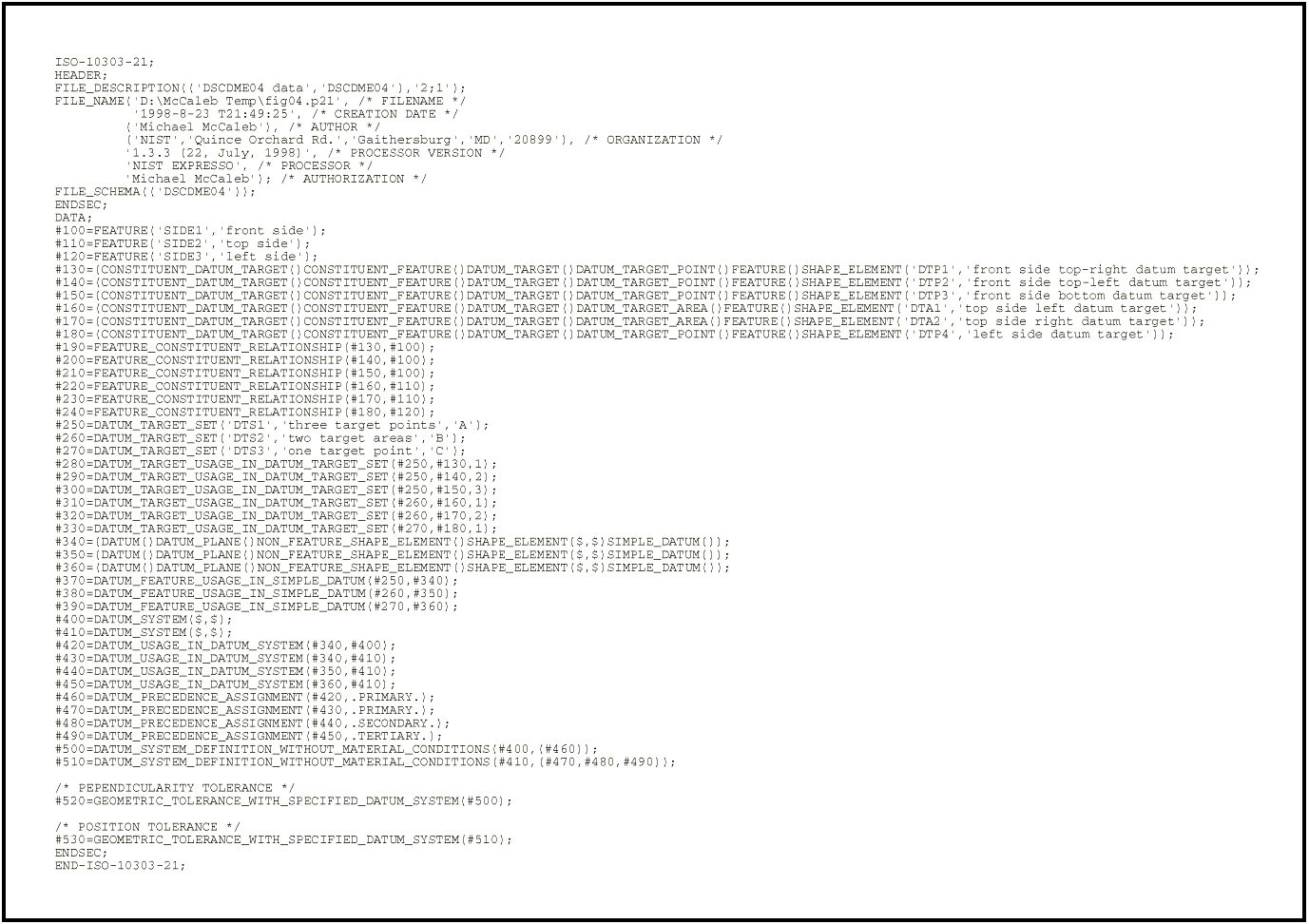
Table E.2. Data population that corresponds to the
technical drawing presented in Fig. 10.
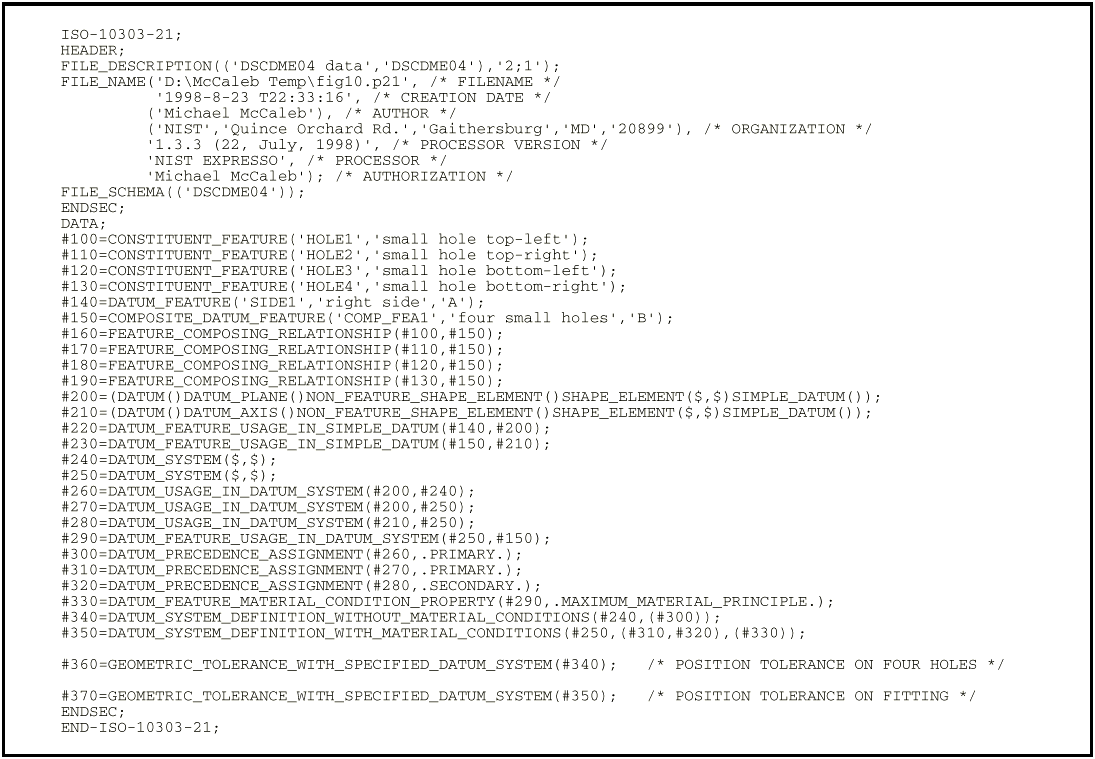
Table E.3. Data population that corresponds to the
technical drawing presented in Fig. 12.
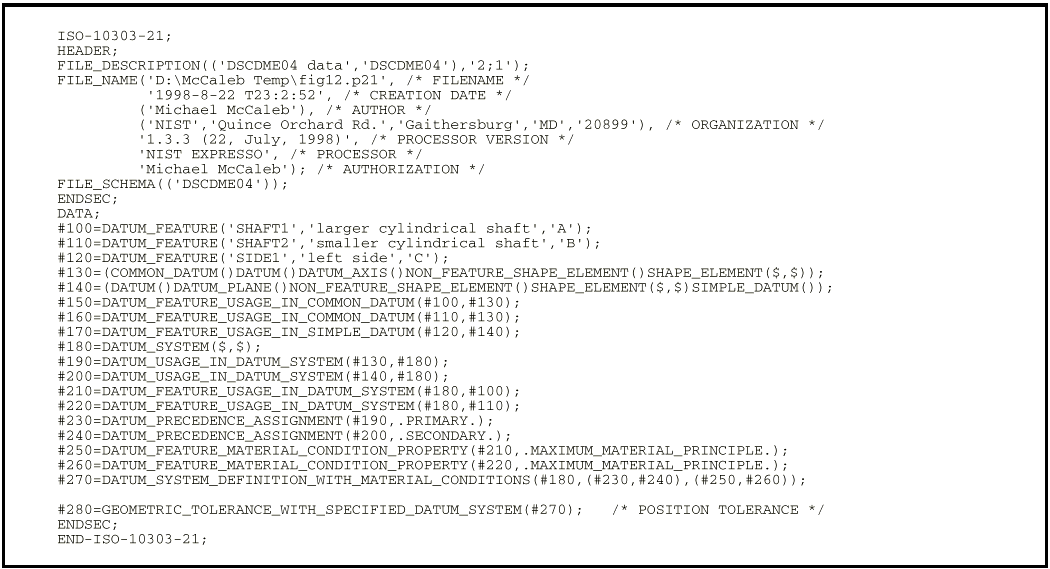


1.
Figures from L. Foster, GEO-METRICS IIIm, (pages 260 &
265). 1994 Addison Wesley Longman Inc. Reprinted by
permission of Addison Wesley Longman. ASME Y14.5M-1994
figures 4-1, 4-5, 4-14, 4-19, 4-20,4-22, 4-23 were
reproduced with the permission of the American Society of
Mechanical Engineers, ASME.Copyright remains with ASME.
Figure 6-46 of Design Dimensioning and Tolerancing, Bruce
A. Wilson, was reproduced with the permission of the
Goodheart-Willcox Company, Inc. Copyright remains with
Goodheart- Wilcox Company, Inc. Figure 42 taken from ISO
5459:1981; portions of clauses 2.4.4.2 and 2.4.4.4 and
2.4.4.5 taken from ISO 10303-41:1994; portions of clause
4.4.2 from ISO 10303-45:1998; and portions of clauses 4.4.1
to 4.4.5 and 6.4.4 taken from ISO 10303-47:1997 have been
reproduced with the permission of the International
Organization for Standardization, ISO. These standards can
be obtained from the American National StandardsInstitute,
ANSI,11 West 42nd Street, 13th floor, New York, N.Y. 10036,
USA or directly from the Central Secretariat, ISO, Case
postal 56, 1211 Geneva 20, Switzerland. Copyright remains
with ISO. The author would like to thank Frederick Tolmie
for the useful discussions concerning this research.
Additionally, the author would like to thank Margaret
Sheehan McCaleb for her invaluable editorial assistance.
-
NOTE — The clause and figure numbers specified in
the above acknowledgments are from their respective
sources and should not be confused with the clause and
figure numbers of this paper.
-

References
- S. C. Feng, and Y. Yang, A Dimension and
Tolerance Data Model for Concurrent Design and
SystemsIntegration, J. Mfg. Syst. 14 (6), 406
– 426 (1995).
- ISO International Standard 10303-47:1997,
Industrial automation systems and integration —
Product datarepresentation andexchange — Part 47:
Integrated generic resources: Shape variation tolerances,
International Organization for Standardization, Geneva,
Switzerland (1997).
- ISO International Standard 10303-11:1994,
Industrial automation systems and integration —
Product data representation andexchange — Part 11:
Description methods: The EXPRESS language reference
manual, International Organization for Standardization,
Geneva, Switzerland (1994).
- ASME Standard Y14.5M-1994, Dimensioning and
Tolerancing, The American Society of MechanicalEngineers,
New York, NY (1994).
- ISO International Standard 1101:1983,
Technical drawings — Geometrical tolerancing
— Tolerancing of form, orientation, location and
run-out — Generalities, definitions, symbols,
indications on drawings, International Organization for
Standardization, Geneva, Switzerland (1983).
- ISO International Standard 5459:1981,
Technical drawings — Geometrical tolerancing
— Datums and datum-systems for
geometricaltolerances, International Organization for
Standardization, Geneva, Switzerland (1981).
- ISO Draft International Standard 10303-210:
— Industrial automation systems and integration
— Product data representation and exchange —
Part 210: Application Protocol: Electronic assembly,
interconnect and packaging design (to be published).
- L. W. Foster, Geo-metrics IIIm, the metric
application of geometric dimensioning and tolerancing
techniques, as based uponharmonization of national and
international standards practices, Addison-Wesley
Publishing Company, Inc., Reading, MA (1994).
- ISO International Standard 2692 Amendment
1:1992, Technical Drawings — Geometrical
tolerancing — Maximum material principle Amendment:
Least material requirement, International Organization
forStandardization, Geneva, Switzerland (1992).
- ISO International Standard 2692:1988,
Technical Drawings — Geometrical tolerancing
— Maximum material principle, International
Organization for Standardization, Geneva, Switzerland
(1988).
- ISO International Standard 10303-41:1994,
Industrial automation systems and integration —
Product data representation andexchange — Part 41:
Integrated generic resources: Fundamentals of product
description and support, International Organization for
Standardization, Geneva, Switzerland (1994).
- ISO International Standard 10303-45:1998,
Industrial automation systems and integration —
Product data representation andexchange — Part 45:
Integrated generic resources: Materials, International
Organization for Standardization, Geneva, Switzerland
(1998).
- B. A. Wilson, Design Dimensioning and
Tolerancing, The Goodheart-Willcox Company, Inc.,
SouthHolland, IL (1996).
- D. A. Madsen, Geometric Dimensioning and
Tolerancing, The Goodheart-Willcox Company, Inc., South
Holland, IL (1995).
- ISO Draft International Standard
10303-47:1995, Industrial automation systems and
integration — Product data representation and
exchange — Part 47: Integrated generic resources:
Shape variation tolerances,International Organization for
Standardization, Geneva, Switzerland (1995).
- ISO International Standard 10303-21:1994,
Industrial automation systems and integration —
Product data representation andexchange — Part 21:
Implementation methods: Clear text encoding of the
exchange structure, International Organization
forStandardization, Geneva, Switzerland (1994).

About the author: Michael R. McCaleb is an
electronics engineer in the Electricity Division of the
Electronics and Electrical Engineering Laboratory at NIST.
The National Institute of Standards and Technology is an
agency of the Technology Administration, U.S. Department of
Commerce.
 [8].
[8].




 .
.
 ) indicate in which datum target sets the
associated datum targets are used.
) indicate in which datum target sets the
associated datum targets are used.

 ) that is
preceded immediately by a datum feature letter or at
least one maximum material principle symbol(
) that is
preceded immediately by a datum feature letter or at
least one maximum material principle symbol(
 ) that is preceded immediately by a datum
feature letter, e.g.,
) that is preceded immediately by a datum
feature letter, e.g.,  (the
(the  .
.


 (the
(the  (the
(the







 feature control
frame of the position tolerance in Fig. 6 indicates
that the primary datum is established from datum
feature A in conjunction with datum feature B. If the
Part 47 model was used to describe this requirement,
the identification attribute of the Datum
entity would have a value of“A – B.”
However, it would be unclear as to which datum feature
is identified as A and which datum feature is
identified as B.
feature control
frame of the position tolerance in Fig. 6 indicates
that the primary datum is established from datum
feature A in conjunction with datum feature B. If the
Part 47 model was used to describe this requirement,
the identification attribute of the Datum
entity would have a value of“A – B.”
However, it would be unclear as to which datum feature
is identified as A and which datum feature is
identified as B.
 ). Also, Fig. 6
shows that datum feature B (the inner hole surface on
the right side) is used to establish the primary datum
(another center axis) of the datum system specified by
a concentricity tolerance and a perpendicularity
tolerance (i.e.,
). Also, Fig. 6
shows that datum feature B (the inner hole surface on
the right side) is used to establish the primary datum
(another center axis) of the datum system specified by
a concentricity tolerance and a perpendicularity
tolerance (i.e.,  , and
, and  ).
Furthermore, both datum features Aand B are used once
again to establish the primary datum (yet another
center axis) of the datum system specified by the
position tolerance (i.e.,
).
Furthermore, both datum features Aand B are used once
again to establish the primary datum (yet another
center axis) of the datum system specified by the
position tolerance (i.e.,  ). As the Part 47
model limits the number of datums that may be
established from a datum feature to one, this situation
cannot be represented with the Part 47 model.
). As the Part 47
model limits the number of datums that may be
established from a datum feature to one, this situation
cannot be represented with the Part 47 model.
 and
and  datum target frames is associated with two datum target
sets, F and G, each of which is used to establish a
separate datum. As the Part 47 model limits the number
of datums that may be established from a datum target
to one, this situation cannot be represented with the
Part 47 model.
datum target frames is associated with two datum target
sets, F and G, each of which is used to establish a
separate datum. As the Part 47 model limits the number
of datums that may be established from a datum target
to one, this situation cannot be represented with the
Part 47 model.

 and
and  datum target frames make updatum
target set A. Additionally, the two datum target
areas (hatched regions are used to indicate datum
target areas) that are connected to the
datum target frames make updatum
target set A. Additionally, the two datum target
areas (hatched regions are used to indicate datum
target areas) that are connected to the  and
and  datum target frames constitute datum
target set B. Also, the datum target point that is
connected to the
datum target frames constitute datum
target set B. Also, the datum target point that is
connected to the  datum target
frame makes up datum target set C.
datum target
frame makes up datum target set C.
 datum target frames isassociated with two datum
targets sets, C and G. This datum target is
identified by a datum target number of
“1” when it is associated with datum
target set C and is identified by a datum target
number of“2”when it is associated with
datum target set G.
datum target frames isassociated with two datum
targets sets, C and G. This datum target is
identified by a datum target number of
“1” when it is associated with datum
target set C and is identified by a datum target
number of“2”when it is associated with
datum target set G.
















 ) has been placed
after each of the attribute names to indicate the
attribute's order.
) has been placed
after each of the attribute names to indicate the
attribute's order.
 and
and 


